Where to Stay in London: Complete Guide for First Timers
London is one of our absolute favorite cities in the world. It has a world-class art and culture scene (including free museums, which we’re here for), food scene (the food markets are our favorite thing in London), and a rich and interesting history that will keep just about every traveler busy while they’re in town.
We’ve been to London multiple times over the last few years – including one two week trip and a separate 10 day trip – and we still have things that we haven’t quite gotten to just yet (Kew Gardens, for example).
There is so much to do, see, eat, and drink that, on our trip a few years ago – which spanned two full weeks – we had big plans to leave the city for a few day trips, thinking “we’ll have plenty of time!”
Turns out, we never left the city, and we had to push those day trips to our next visit because there was simply far too much to do in London, and we never ran out or got tired of it.
When I (Matt here) returned for another 10 days, I had a similar experience where I had planned to do two or three day trips, and instead found myself struggling to find the time to fit even one in (we did make it out to Oxford, and it was lovely!).
In this guide, we’re going to use our experiences exploring the city to do our best to walk you through all the information you need to figure out where to stay in London for your particular style, budget, and preferences.
We’re going to give you four main neighborhoods we’d recommend, why we recommend them, and then quickly go through three additional neighborhoods we like that might not make sense for your first visit, and three that we’d steer clear of (mostly because they don’t offer a great value).
Each neighborhood offers a different blend of vibes, prices, and pros and cons, and we’ll cover it all below so that you’re armed with all the information you need to figure out where to stay for your particular style and budget.
Our intention is that, by the end of this guide, you have everything you need to choose the right place to stay in London for you and your travel companions.
Sound good to you? Let’s get into it.
Important note: This is a long guide with lots of detail (it got longer and longer as we put it together), but we’ve done our best to structure it with headings, a helpful summary at the top, and a table of contents to help you navigate it without reading literally every word.
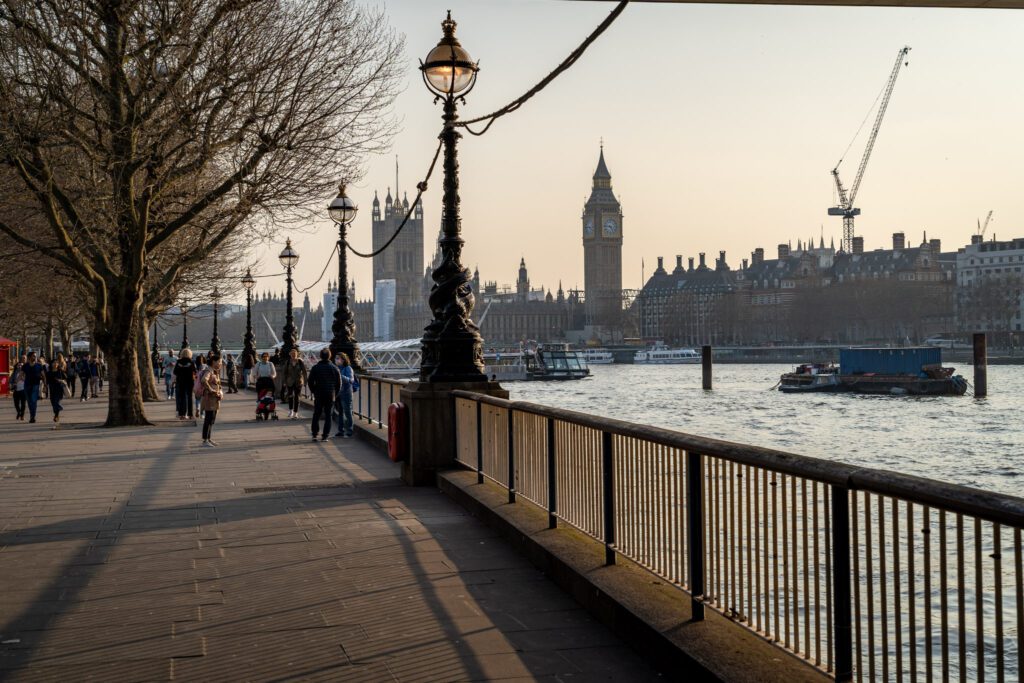
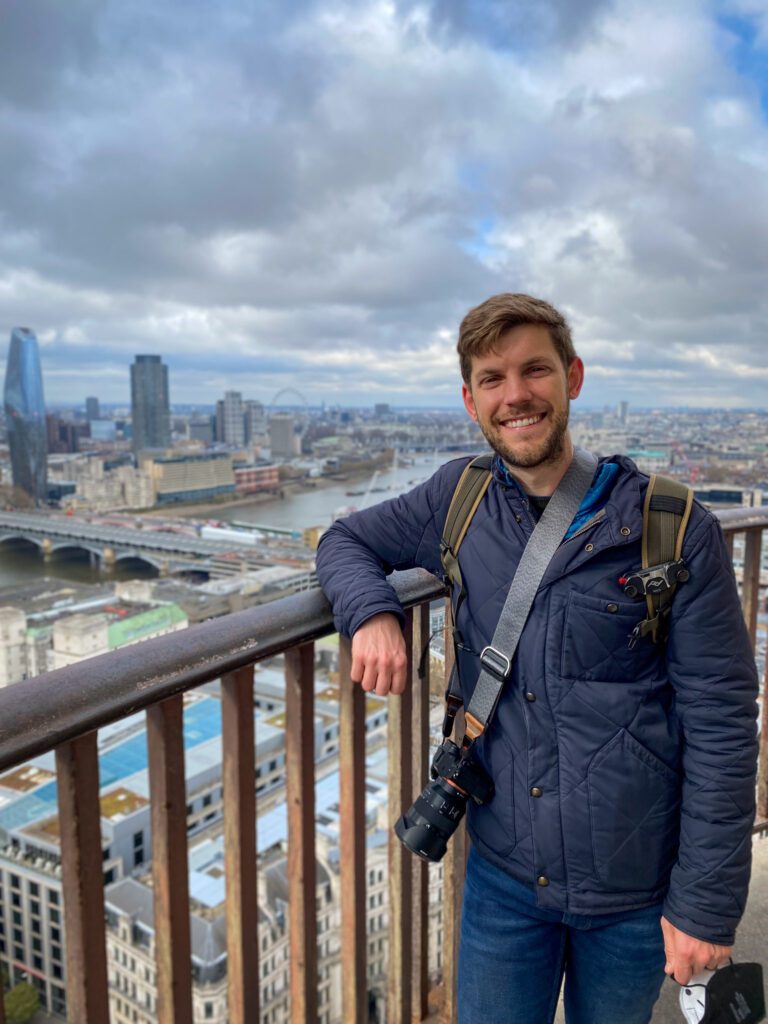
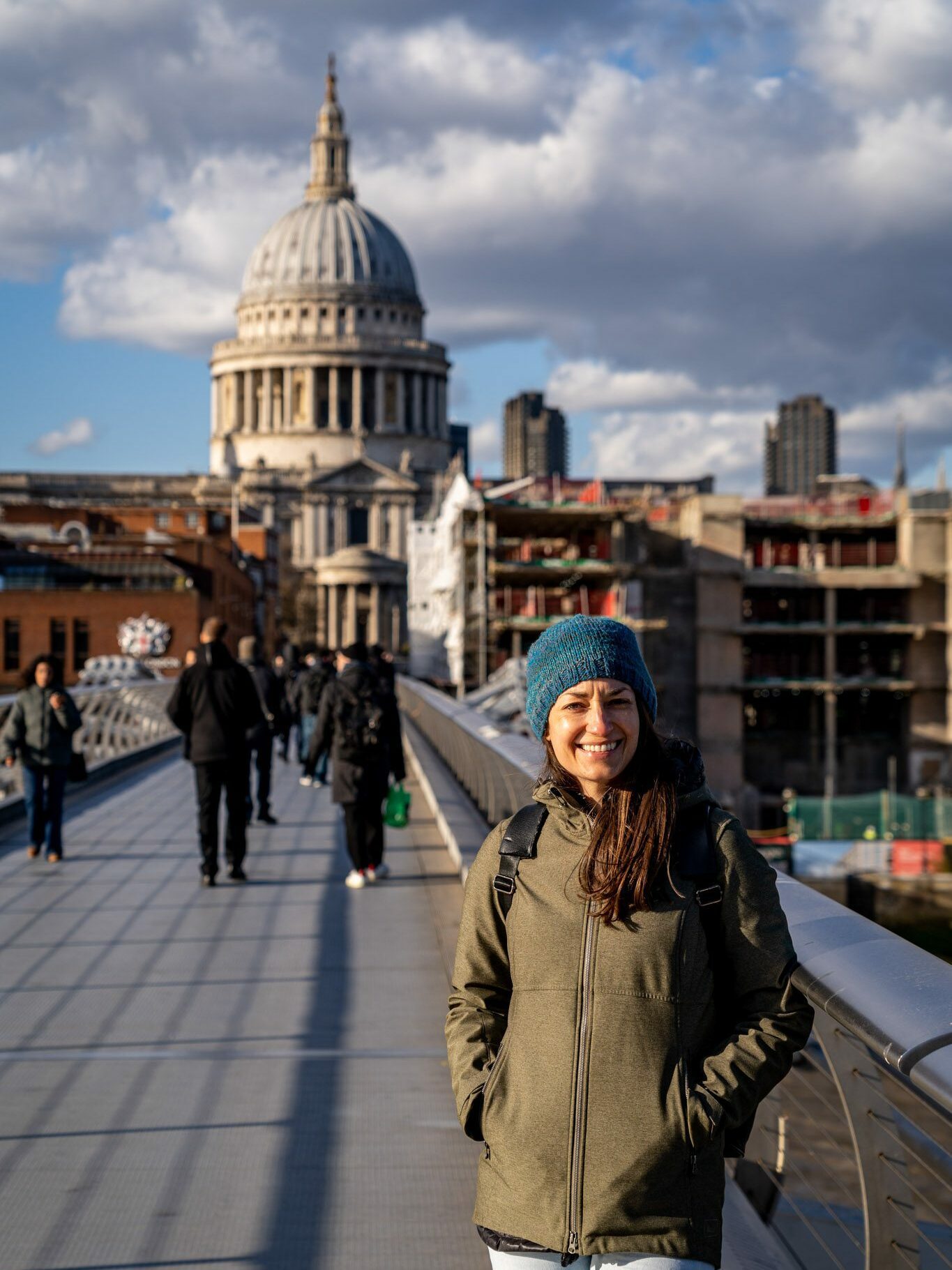
Disclaimer: Some of the links in this post, like hotel links, are affiliate links, meaning at no additional cost to you, we make a little bit of money if you click through and book. That being said, we would never recommend something to you that we don’t stand behind 100%.
Where to Stay in London: The 4 Best Areas to Stay
Let’s get straight into it here, because we have a lot to cover.
As you’re starting to plan your trip to London, you’re going to notice two things pretty quickly.
First, London is massive.
Similar to Paris, it’s hard to understand just how big London is until you get there and find yourself saying things like “yeah that’s totally walkable” before putting it into Google Maps and realizing it’s an hour away.
There are so many potential places to stay, and we’ve done our best here to narrow them down to a more manageable, digestible list that is far less overwhelming (especially if it’s your first time).
Second, where you decide to stay is going to shape the rest of your trip.
Staying in the hustle and bustle of a place like London’s West End is going to feel very, very different than staying in, say, Hackney, which is much more residential and low key.
Now, we’re well aware that a few of you are currently ready to throw your left shoe at the screen, saying “I don’t have time to read all of that, JUST TELL ME THE BEST PLACE TO STAY!”
Well, here’s a quick summary of this guide if you’re short on time (though we’d recommend reading the section of the place you end up staying for tips and places to add to your list!).
There are plenty of details in the rest of the guide below this section for your reading pleasure, if you’re interested.
If it’s your first time in London, you can’t go wrong with Covent Garden.
Covent Garden is akin to the Centro Storico in Rome or Florence (or any Italian city, really) or Le Marais in Paris. Not because it’s the oldest part of the city (that’s the City of London), but because it’s the beating heart of the city in a lot of ways.
It’s central, well connected, and will put you in a perfect position to explore the adjacent neighborhoods on foot and zip around the city on public transit.
Stay at Page8 (which is literally across from the National Gallery) if you’re looking for a hip boutique hotel, or at the Z Hotel Covent Garden if you’re looking for something more affordable.
For more space, look at Cove Arne Street, an aparthotel we almost stayed at (but chose the City of London location below instead).
If you’re looking to stay in our favorite neighborhood in London, stay in Bankside (which is part of the borough of Southwark).
While the Tube connections are slightly worse than the other two central neighborhoods we like (more on them in a second), we much prefer the vibes on the south side of the river (especially on the weekends, when the City of London – which is essentially the Financial District – is a dead zone, and many of the businesses are closed).
We’ve stayed at CitizenM Bankside, and we loved it. It was actually our first CitizenM stay, and we’ve since stayed at three of their other locations around the world (if that tells you anything about how our experience went).
I also stayed at Native Bankside on my latest trip, a modern aparthotel with kitchen facilities in each room, which we also liked for a longer stay (I like to have more space because I do a lot of my best writing on location).
If it’s a short trip and you’re looking for the most convenient location possible to maximize your time, we’d go with the City of London.
We’ve stayed here multiple times now, and while it’s not necessarily the most charming part of the city, it is certainly among the most convenient.
Which isn’t surprising considering that it’s essentially London’s Financial District, and thus has great connections to most parts of the city (including, crucially, London Heathrow).
If you’re looking for a hotel with a good value, take a look at the City of London Club.
If you want a little more space, we’ve stayed at both Cove Cannon Street and Native King’s Wardrobe, two nice aparthotels a few blocks from St. Paul’s Cathedral would be a great choice.
If you want to stay in the hippest part of the city with great food, drinks, and nightlife, stay in Shoreditch / Spitalfields.
The markets here are must-visits – Spitalfields Market, Brick Lane, and the Sunday Upmarket – and the area has a great blend of location and vibes (it’s all skaters and street art).
One Hundred Shoreditch is the place to stay to be in the middle of all the action in Shoreditch, and if you’re looking for a unique experience, there are two pubs with rooms above them that would be a fun way to spend a few nights in London (the Culpeper and the Buxton).
If you’re on a tight budget, there’s no one neighborhood that we’d point you to.
Instead, we’d point you towards a hotel chain that focuses on value at the expense of bigger rooms and luxurious amenities: Z Hotel.
They’re a reliable, budget-friendly option where the room is a place to sleep and that’s it. We like the location of their Strand hotel, which is between the river, Covent Garden, and Trafalgar Square.
The Kensington Gardens Hotel is another good option for no-frills rooms at a reasonable rate in a relatively central location (walkable to the Tube).
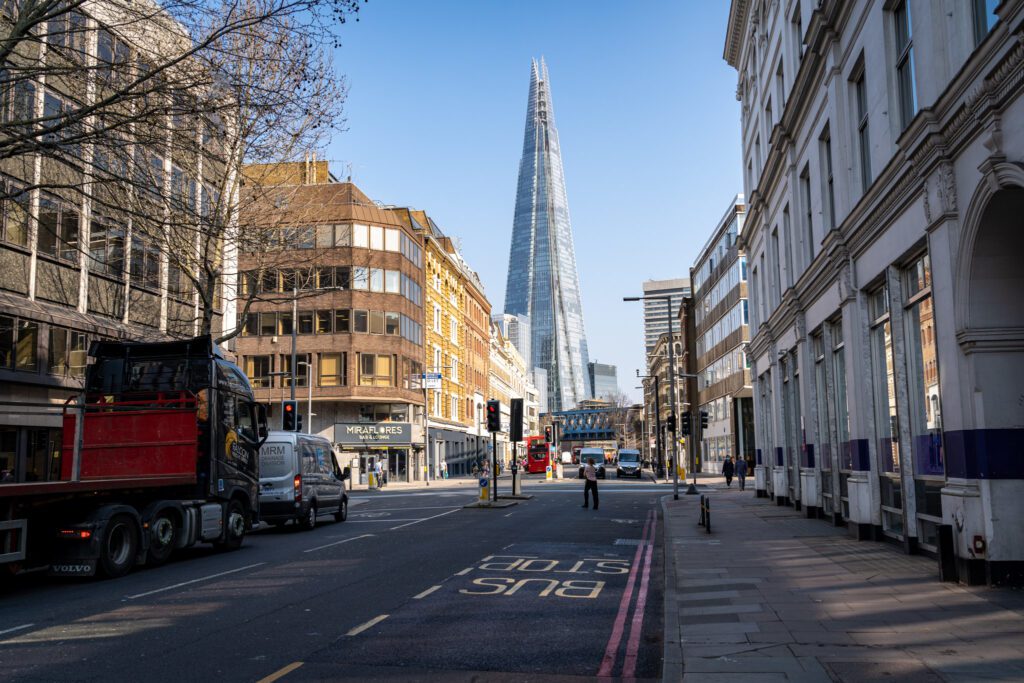
For each of the neighborhoods below, we’ve created a structure to help you figure out if it’s the right home base for you.
Here’s what we’ll cover:
- An overview of the neighborhood and our experience with it. We’ve personally been to and explored (more than once) all of the areas on this list, so we’ll try to give you a little bit of our perspective on what makes each area special.
- Pros and cons of staying in this area. The things you need to know to make your decision.
- A collection of a few places to stay that stood out to us. Sometimes it’ll be because they have rooms with great views, sometimes it’s the rooftop pool, sometimes it’s that the hotel offers a great value given the location.
Where We’ve Stayed in London
We like to start this type of guide by going through our own personal experiences staying in London.
Now that this section covers several trips to London (rather than just one or two), we decided that we should probably just make it easy for you and lay out all of the places we’ve stayed on our many trips in one place without the narrative fluff.
Here are the places we have personally stayed in London over the past few trips, and a few brief thoughts on their offering and location (you’ll find more in their sections in the main guide below).
CitizenM Bankside (Bankside): This modern hotel is a great, relatively affordable (relatively in the sense that nothing in London is truly affordable) home base for exploring most of Central London.
CitizenM is our favorite hotel chain in the world, and we’ve stayed at several (four, at the time of writing) of their locations around the world and found a remarkably consistent offering at all of them.
It’s almost as if they designed it so that no matter which of their hotels you stay in, the experience is consistent.
Their whole schtick is that the rooms are small, and do one thing really, really well – they provide a great night of sleep with blackout curtains, soundproofing, and huge super comfortable beds.
The things that you might find in a different hotel room – a coffee maker, an iron, and other items of that nature – are moved into common areas so that they can keep the cost of the rooms down. Not great for groups or people who aren’t couples (the bathroom is basically in the center of the room), but it was great for us!
Cove Cannon Street (St. Paul’s): We wanted an apartment in the City of London on one of our previous London trips, so we booked one at COVE Cannon Street.
It is kind of like a hotel in terms of the check-in process and 24 hour reception (you can leave your bags!), but the rooms have kitchens and significantly more space.
We liked it, and we easily walked to Tower Bridge, St. Paul’s, and Spitalfields Market from here (among plenty of other places).
Native King’s Wardrobe (St. Paul’s): This is another nice aparthotel in a historic building with 24/7 reception (which I’ve found is somewhat helpful because it means luggage storage!), and it’s only a few blocks from Cove Cannon Street right at the base of St. Paul’s Cathedral and a few blocks from Millennium Bridge.
Good metro connections (Blackfriars and St. Paul’s give you access to the Central and District lines), good bus connections (we took the 26 in both directions over to Covent Garden and up to Shoreditch and Hackney multiple times), and walkable to just about everything.
Apartments are stylish and spacious, with nice kitchens and seating areas and heating + A/C.
Native Bankside (Bankside): In contrast to their location at King’s Wardrobe, this Native aparthotel is much more modern (to the point of absurdity – we had trouble figuring out how to turn off the lights, and we’re two millennials used to smart home stuff!) and is basically one block off of the promenade along the south side of the Thames.
Less plentiful metro connections here – we walked across Millennium Bridge to get the metro most times. More compact, but better shared facilities (lounge and gym, mostly).
Mirabilis Apartments (Camden): We wanted to spend some time in a place other than central London, and we settled on Camden Town.
We went with Mirabilis Apartments, and would recommend it based on the location (one block to the Tube, 5-10 minutes to both King’s Cross and Camden Market) and the apartments themselves.
We slept great, had a full kitchen, and the apartment was pretty spacious considering it’s London (we both had some work to get done, and this was a great place to do it).
Covent Garden: The Best Location for First Timers in London
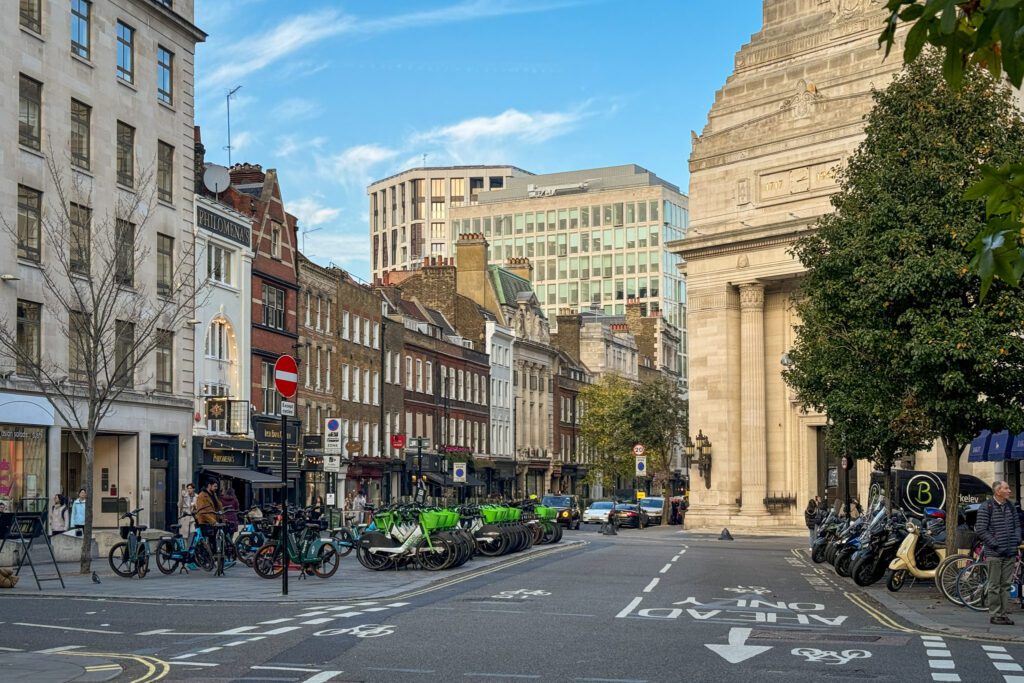
Covent Garden has seen quite the transformation over the course of its existence. For much of London’s early history, this part of the city was outside the city walls and was thus a series of fields and pastures.
When the city of Westminster was established, parts of the city we know as the “West End” were annexed and, eventually, Covent Garden became the site of a fruit market (you’ll still find the “apple market” in Covent Garden today, though the vendors are trading diamond necklaces and expensive clothing rather than produce).
Later in its history, Covent Garden became the red light district, known more for its brothels than its produce (which you can learn about on this walking tour of the neighborhood with a company we did a different tour with and loved).
It’s a little hard to imagine as you’re wandering around Covent Garden today, because now it seems very polished and, if you’ll allow me a British-ism, posh.
Designer stores, fancy restaurants, and people milling about on their way to the theater are common sights.
Let’s quickly talk about geography and naming.
The West End generally refers to the area east of Westminster and north of the Thames, just west of the border of the original City of London that dates back to Roman times.
It includes sub-neighborhoods like Covent Garden, Holborn, and Soho.
As we’ve spent time exploring the West End, we’ve come to the conclusion that there are only certain parts of it that we’d really recommend.
We think Covent Garden is the most charming piece of this part of the city, swapping the wide boulevards lined with designer stores that you’ll find in Soho – which is very much not our vibe – for narrow cobblestone streets and winding alleyways.
Today, the West End is the main hub for entertainment – particularly theater – in London, and is home to multiple important cultural sights like the National Gallery and the British Museum.
The proximity that Covent Garden offers to that entertainment along with its extremely convenient location and plethora of public transit connections makes it an excellent place to stay, particularly if it’s your first trip to London, or if you only have a day or two to explore the city.
We think you’ll find that Covent Garden has much more character than other parts of the West End, and has all the benefits of staying smack dab in the middle of London.
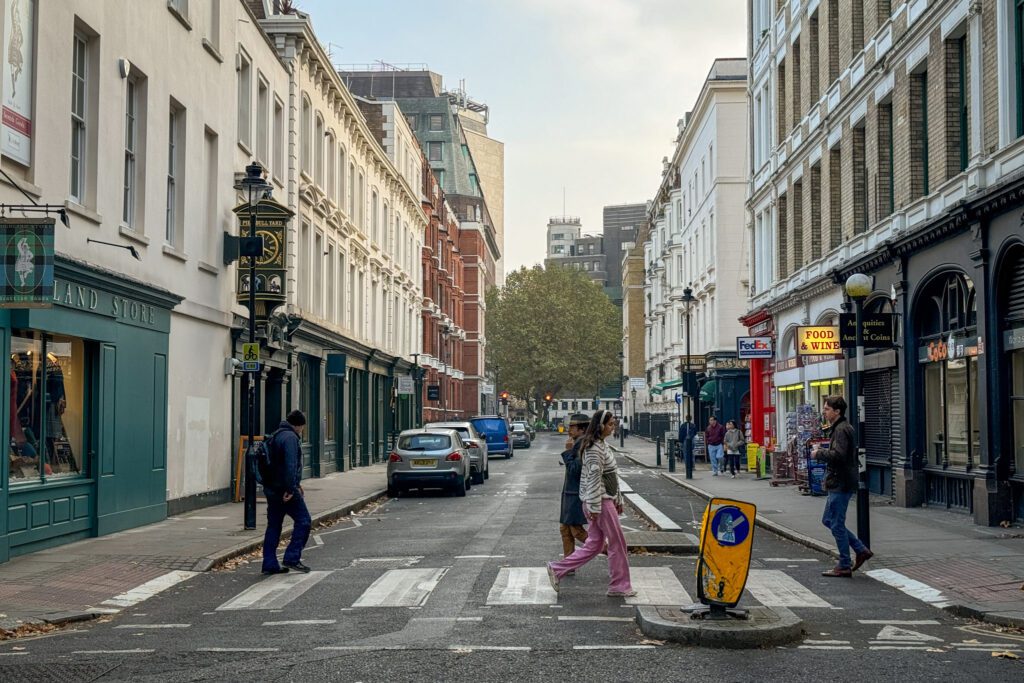
Pros and Cons of Staying in Covent Garden
Here are the pros and cons of staying in Covent Garden, at least as we see them.
Pros of Staying in Covent Garden
It’s charming. With cobblestone streets (that we couldn’t stop tripping over, for some reason) and a mix of architectural styles, this is the most charming part of the touristy center of London, at least in our opinion.
It’s walkable. If you stay here, you’ll have a bunch of the main sights in London on your doorstep – Leicester Square, Trafalgar Square and the museums, Big Ben and Westminster Abbey, and more.
Plus, if you’re up for a bit of a walk, you’ll be within walking distance of Southbank, Mayfair, and Hyde Park too.
Cons of Staying in Covent Garden
It doesn’t get much more expensive than Covent Garden. London is an expensive place to visit to begin with, and Covent Garden is perhaps the most expensive part of the city.
There are a few more budget-friendly options (namely the two Z Hotel locations – Strand and Trafalgar), but generally speaking, it’s not going to be cheap.
It can be busy and loud. The proximity to many of the places we mentioned in the walkable section above – like Leicester Square and Trafalgar Square – means that this area is always teeming with people. Quaint and quiet are not words that will be used to describe Covent Garden.
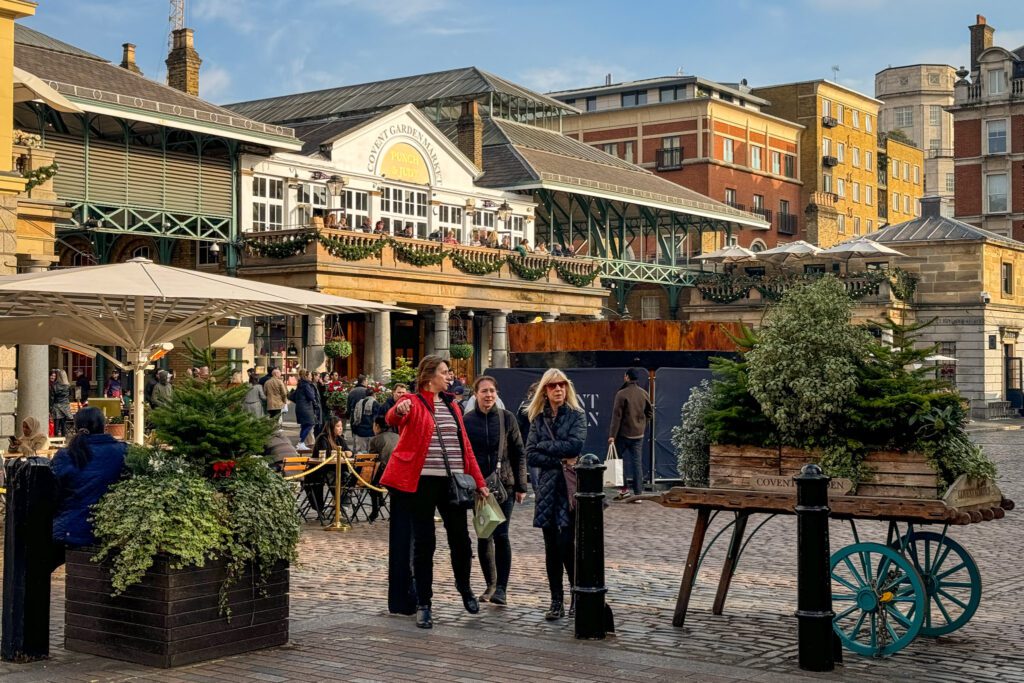
The Best Places to Stay in Covent Garden
Here are some places to stay in Covent Garden that caught our eye.
Page 8 Hotel: A Stylish Hotel in a Great Location
If we were choosing a place to stay in Covent Garden, Page8 would be our top pick in terms of hotels.
It’s at the southwestern corner of the neighborhood, a few blocks from Trafalgar Square and all of the theater options nearby, and it’s modern, stylish, and in a great location.
Page Hotels (there are currently two of them at the time of writing, London and Hong Kong) are built for “Urban Explorers” in their own words. What, exactly, does that mean? Great question!
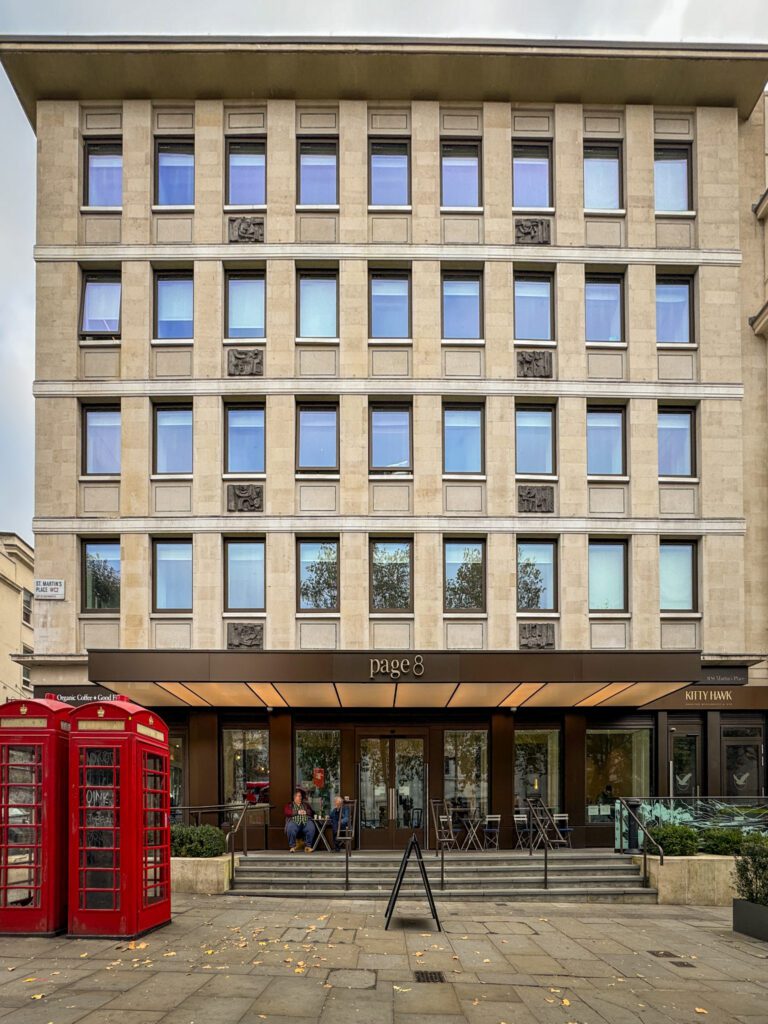
As two people who are probably right in the target demographic for this hotel, here’s our take.
Like many of our favorite hotels, they have a philosophy that combines comfortable, compact rooms with sprawling common spaces that are perfect for connecting with like minded travelers, or just reading a book and watching the world go by.
The rooms are about average size here, though they do have some bigger room options with more space to relax. It’s also worth noting that they have family rooms with two queen beds, if you’re traveling with a group who wants to all stay in the same room.
You’re not going to find all the bells and whistles in your room that you might get at a more traditional hotel, but they have included some of the most important things that we refuse to skimp on, like comfortable beds and soundproofed rooms.
They also have free tea and coffee in the room, which is usually something that gets cut, and we think the Marshall speakers are a fun, vintage touch.
As far as common spaces go, they’ve done a good job of designing them to be full of light and warmth, which makes it an inviting place to hang out rather than a place you’re trying to get out of as fast as possible to either get to your room, or out into the city.
There’s a coffee bar (of course there is) for a quick morning caffeine fix (if the in-room coffee isn’t what you’re looking for), and every surface in the common areas and rooms is full of a selection of coffee table books that will have you wishing you had better taste in coffee table books in your own home.
The Z Hotel Covent Garden: An Affordable Hotel in London (!!)
Z Hotels is a chain of mid-range hotels in London (with some other locations in the UK) that brings a blend of style, affordability, and great locations to the table.
With those three boxes checked, we think the Z Hotel Covent Garden would be a fantastic home base for exploring London.
However, there is an important caveat. In order to deliver both style AND affordability, you’re going to have to be okay with smaller rooms and fewer amenities than you might get at true luxury hotels (BYOFS – bring your own fluffy slippers).
It’s similar to CitizenM – our favorite hotel chain in the world – in that regard.
You won’t have a phone, a safe, or a minibar in the room (which means no fridge). You will find comfortable beds and TVs with plenty of entertainment options, as well as air conditioning for those seven days a year where you might need it in London.
The rooms are small, but they’re extremely well thought out, with plenty of room for a couple to stay in without being overly cramped.
They also have family rooms with multiple beds, but it’s worth noting that most rooms are only really designed for 1-2 people.
COVE Arne Street: Serviced Apartments, Perfect for Groups of All Sizes
We stayed with COVE at their location on Cannon Street in the City of London, and were super impressed from the beginning to end of our stay.
We always prefer staying in apartments, but we avoid vacation rentals in cities if we can, and enjoy the convenience of 24 hour reception that hotels bring to the table.
COVE Arne Street is a similar experience to their other location where we stayed, but it’s right in the heart of Covent Garden, which is arguably a more charming and interesting location than the City of London.
Choose from one, two, and three bedroom apartments that can accommodate anywhere between 2 and 10 guests (if a few are cool with sleeping on the sofa bed).
The beds are comfortable (in our experiences), the kitchens are nice (and stocked with everything you need to cook, for the most part), and it’s a spacious and comfortable space to hang out in.
If you want the amenities of an apartment in London, this is the place we’d recommend (along with their other location in the City, which is where we stayed).
Southwark / Bankside: Our Top Pick in London
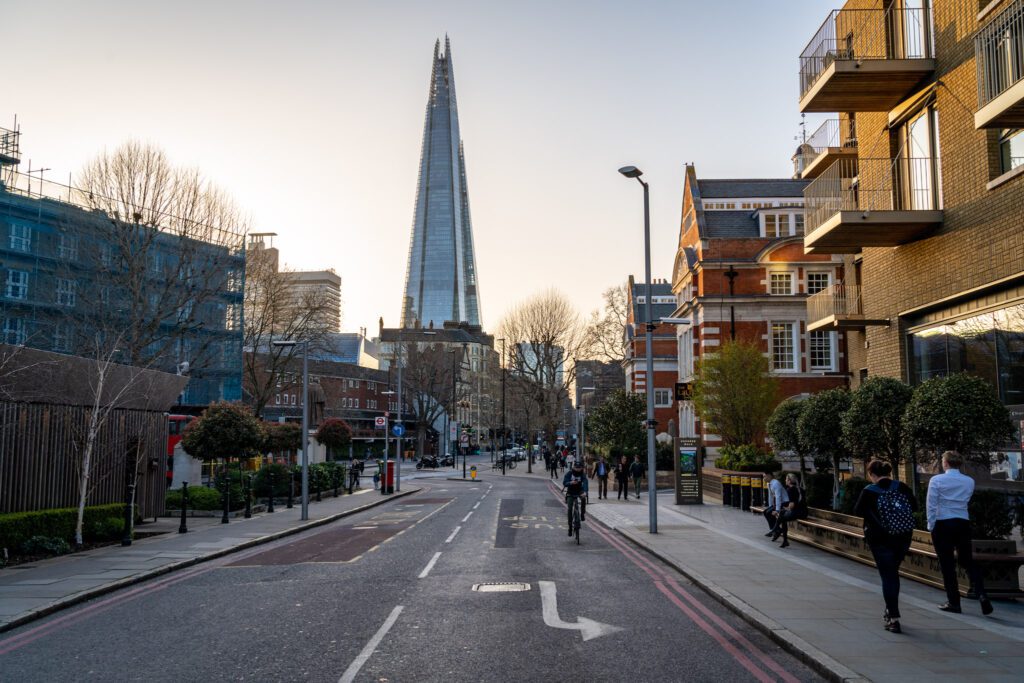
When I touch down in London, I’m generally jetlagged and tired from a long flight from the west coast.
To combat that jetlag and stretch my legs, I head out to the southern bank of the Thames and walk from Tower Bridge to Westminster Bridge (home of Big Ben), past places like Borough Market (worth a stop for food!), the Tate Modern, and Millennium Bridge.
This stretch – about three miles or so – is my absolute favorite part of London for an early morning (or evening) walk, and it’s a staple on our London itinerary.
It’s packed with things to do, see, eat, and drink, and it’s walkable to many other parts of the city that you’ll be visiting during your trip.
Quickly, let’s talk about the naming here.
Bankside is a small stretch of the broader neighborhood of Southwark.
Bankside is a relatively small part right along the river (hence the name), and Southwark is one of the boroughs of London that stretches pretty far south away from the river.
Generally speaking, the closer to the river the better in this part of the city, at least for your purposes as a tourist.
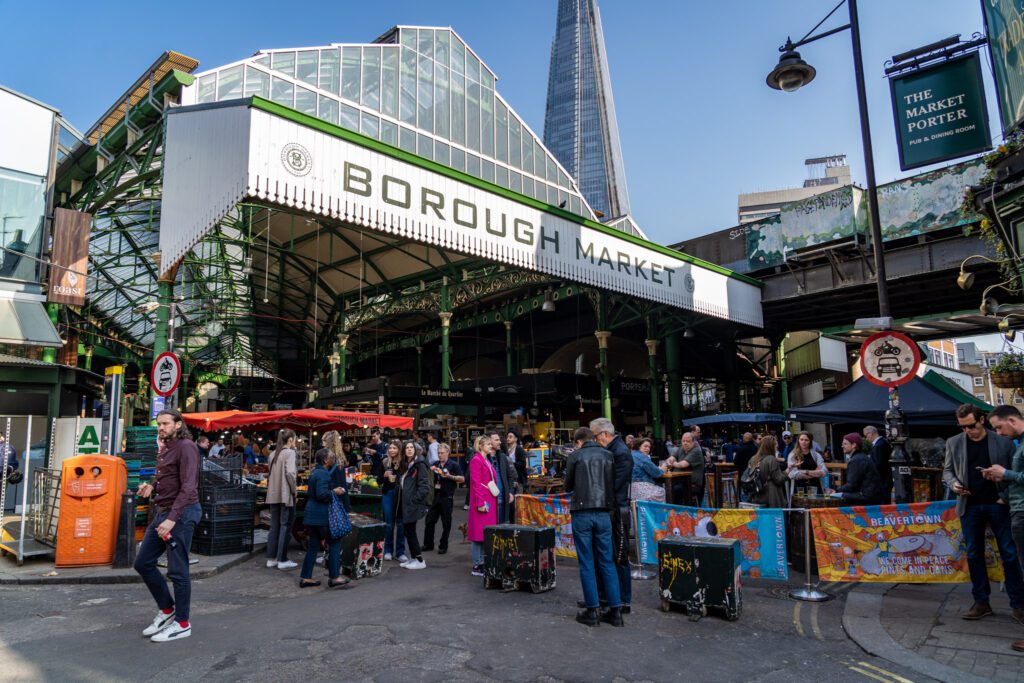
The selection of hotels here is nice, ranging from more affordable (but not particularly interesting) options (the Ibis Styles on Southwark bridge) to gorgeous boutique hotels (the Hoxton), and plenty of options in between.
As we’ll cover below, the City of London (which is a specific neighborhood in London on the north bank of the river) is generally considered the “historic center” of the city, where the Romans, Normans, and the rest of London’s inhabitants over the centuries settled and eventually built a walled city (you can still see pieces of the wall today!).
The strategic spot on the northern bank of the Thames, where you’ll find the Tower of London, is where people ended up settling, and across the river was outside the city walls and thus a relatively lawless place.
It quickly became the entertainment hub of the city (including some less savory forms of entertainment) and that reputation (minus the unsavory parts) is largely true today, with the Royal Festival Hall, Queen Elizabeth Hall, and Globe Theater all on the south bank of the Thames.
The main downside of staying on the south side of the Thames is the fact that transit connections – the Tube, buses, and airport connections – are generally worse south of the river. This was something I noticed when we stayed here, and multiple Londoners confirmed it to be generally correct.
To illustrate the point, on my last trip I stayed at the base of St. Paul’s Cathedral in the City of London and then moved across the bridge to Bankside for the second half of the trip.
To catch the Tube from Bankside, I actually had to walk back across the Millennium Bridge to Blackfriars (the same station we were using from the City of London).
The point here is that staying on the south bank of the Thames is going to mean an extra 10-15 minutes of transit time to get around to other parts of the city.
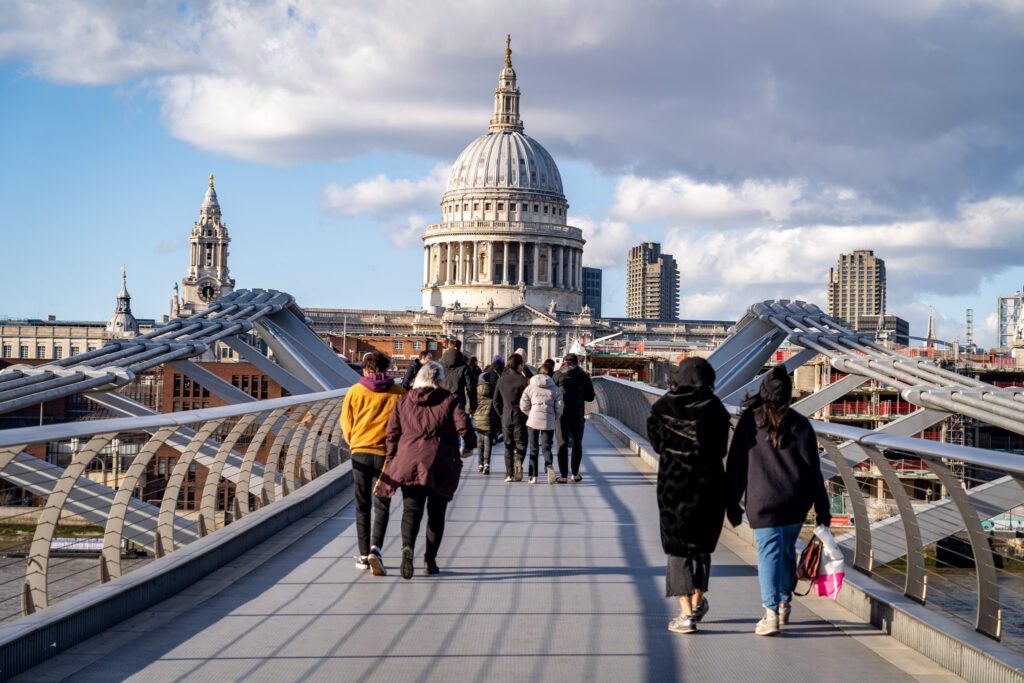
Pros and Cons of Staying in Southwark / Bankside
Here are the pros and cons of staying on the south bank of the Thames as we see them.
Pros of Staying in Southwark / Bankside
It’s central. Being close to the river is a nice amenity, and Southbank has that going for it. You’ll be able to walk to places across the river like the Tower of London and Westminster Abbey.
It’s well-connected. For those places that aren’t walkable, you’ll be well-connected via public transportation to the rest of the city between buses and the Tube, which has helpful stops at Waterloo Station, Southwark, and the Tower of London.
Cons of Staying in Southwark / Bankside
It’s a little sterile. Unfortunately, parts of the south bank of the Thames have become almost identical to other major cities around the world with modern skyscrapers, specialty coffee shops, and more.
It’s pricey. I mean, London is expensive in general, but some of the places in this area are outrageously expensive. But, they also come with river and skyline views, so I suppose that’s part of the reason why. There are a few affordable spots that we’ll get into below.
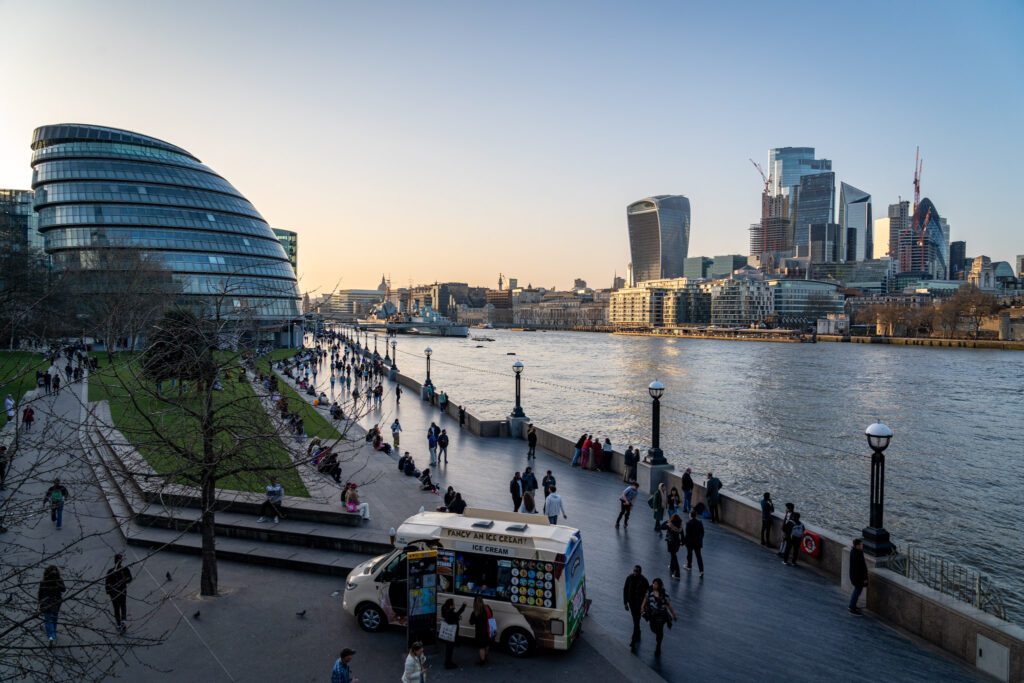
The Best Places to Stay in Southwark / Bankside
Here are some places to stay in the area that caught our eye, including where we spent our first four nights in London.
CitizenM Bankside: A Great Mid-Range Hotel (Where We’ve Stayed)
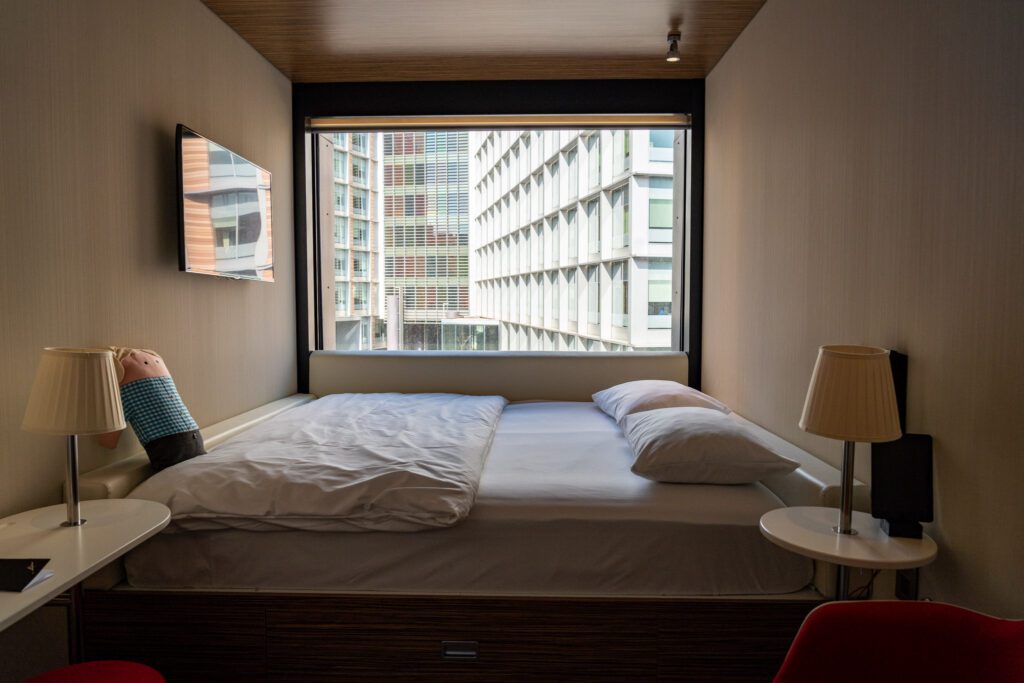
We have a deep love affair going on with CitizenM hotels, having stayed in multiple locations on different continents over the past several months (at the time of writing).
Including four nights at the CitizenM Bankside to kick off a recent trip to London.
The experience at all of their hotels has been remarkably similar – almost like they designed it that way – and everything from check-in to check-out is seamless and well thought out in a way we didn’t think was possible for hotels. Plus, it’s surprisingly affordable!
Breaking from the mold of traditional hotels, CitizenM reimagined what the word “hotel” really means, and the definition they came up with takes everything we think of when we think of chain hotels – aging rooms (with iPod docks), ironing boards, unhelpful staff – and turns it on its head.
Here’s a relatively brief overview of why we love their hotels.
It starts with booking. They have exactly one type of room – a compact room with a gigantic, comfortable king bed – so there’s no analysis paralysis around whether you want the standard, the standard-plus, or the plus-plus-standard room type.
Then comes check-in. Everything is done through screens in the lobby (though a helpful staff member will be right there to help iron out any issues or answer any questions), and you even get to select what side of the building and floor you want your room to be on.
What about the rooms? The rooms are designed for one thing, and they deliver that one thing flawlessly.
That one thing? A great night of sleep. Blackout curtains, temperature control via iPad, and huge, comfortable beds are the name of the game.
We usually don’t sleep well in hotels because of light, noise, and weird beds, but we sleep like babies with CitizenM. They even found a way to stop light coming in from under the door! A miracle!
Did we mention the gigantic, super comfortable bed?
The downside here is twofold. One, small rooms mean very little privacy, so these rooms are probably best for close friends and couples. Two, they only have one room configuration, so families who all want to stay in the same room probably should look elsewhere.
While the rooms are small, they have amazing common areas – like the huge, open lobby that they call the “living room,” which give you a place to hang out other than on the bed.
Sea Containers: A Splurge with Stunning River Views
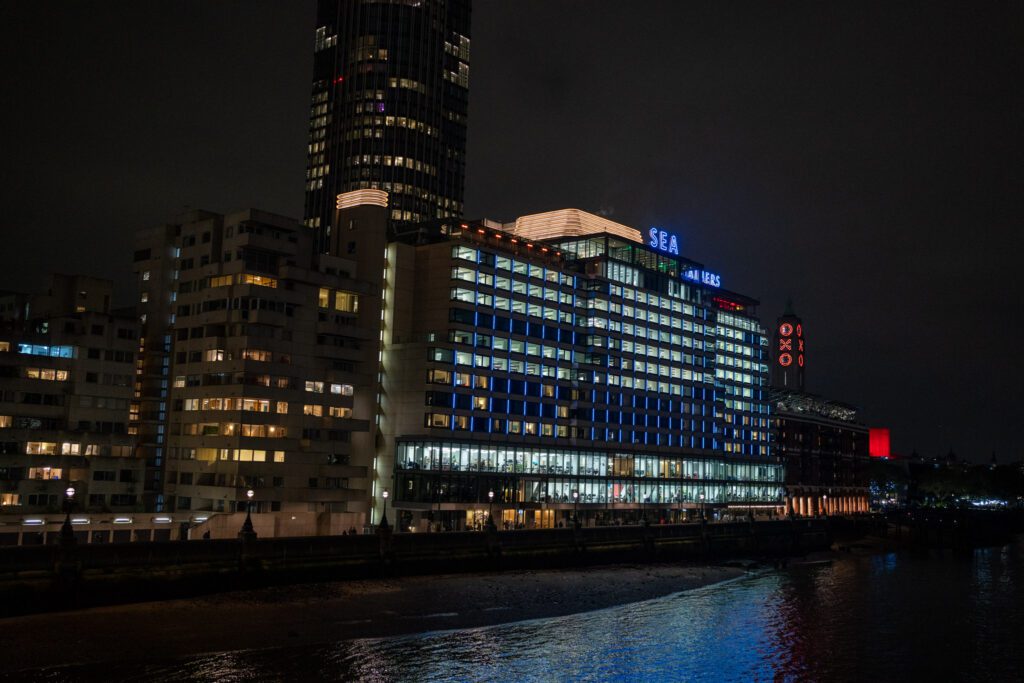
If you’re looking for a splurge in London, Sea Containers is at the top of our list because of the incredible river views from some of their rooms (make sure to book a room with a river view!).
This hotel is right on the south bank of the Thames, and it’s a great location for exploring both sides of the river thanks to Blackfriars Bridge, which is right outside the doors of the hotel.
They’ve designed the hotel to feel like a 1920’s transatlantic cruise liner, which is a fun theme given the waterfront location. In the rooms, you’ll find huge windows, elegant black and white designs with pops of color, and incredible views of London’s skyline.
Standard rooms are more than 300 square feet – GIGANTIC! – and they have studios and suites with even more space. Some rooms even have balconies overlooking the Thames. There’s also a rooftop bar and restaurant with even better views of the London skyline.
This is not a budget stay, by any means, but if you’re looking for a splurge for a special occasion, this is our top pick in London.
Native Bankside: Stylish Aparthotel in Southbank (Where We’ve Stayed)
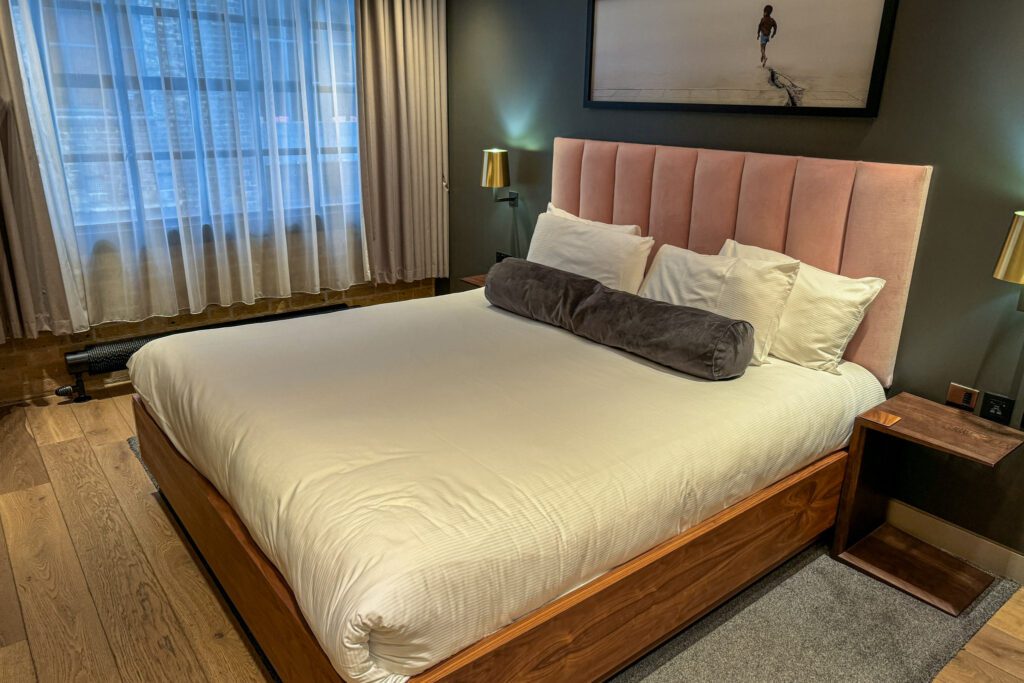
If you’re looking to stay in Southbank and want the extra level of space and comfort that comes with staying in an apartment, look at Native Bankside.
We had initially considered this aparthotel, but decided to stay elsewhere and we saved Native for a trip down the road.
Enter Matt’s trip in November of 2024, when he and his brother stayed here for the second half of their trip.
Like many of the serviced apartments popping up all over the world, Native is a company that combines the convenience and service of staying in a hotel with the extra space and access to a kitchen that you get with an apartment.
Plus, 24/7 reception means staff are always on hand to help (and more importantly, to give you a place to leave your bags!).
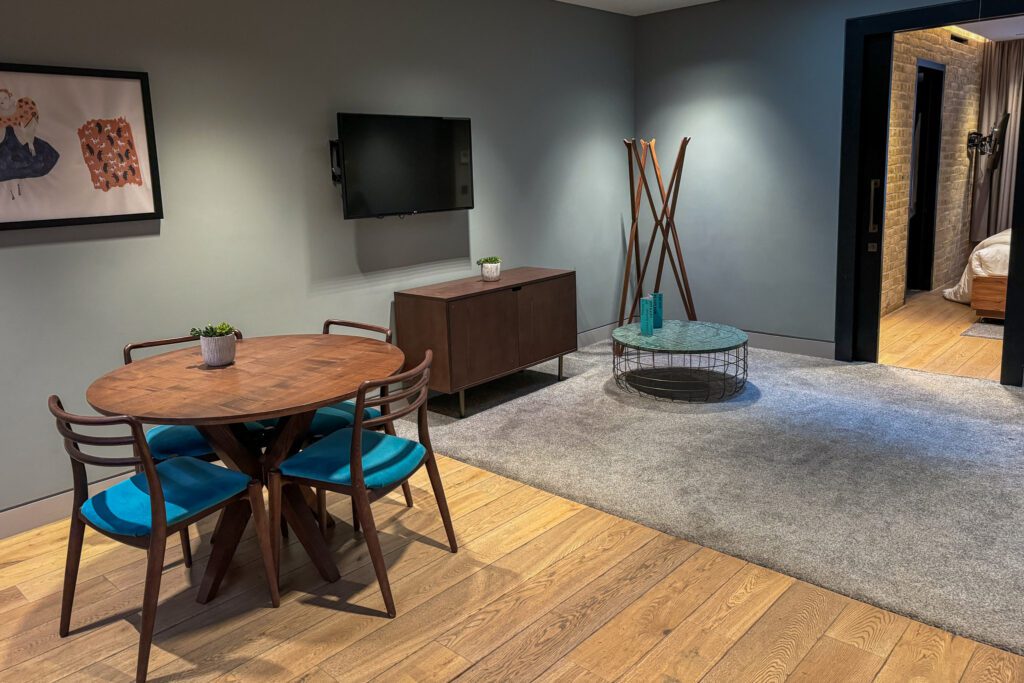
The building is a former tea warehouse in what used to be an industrial area, and they’ve meticulously restored it to bring it into the 21st Century.
Some of the touches are so modern that even my brother and I – two millennials who are fairly tech-savvy – had trouble figuring it out (like the dimming light switches).
To be honest, their smallest rooms aren’t much bigger than a hotel room, but they’re cleverly thought out with pop-out dining tables and a stovetop to give you more amenities than you get in a hotel.
Somehow – and I’m still not sure how – they fit both a dishwasher AND a washing machine into a 300 square foot room. Mind blowing.
They also have bigger rooms – including studios, one, and two bedroom apartments – and the thing they do well is using space efficiently. All rooms have stovetops and ovens/microwaves. As you get up to the one bedroom apartments, you’ll get more space.
The location is right on the south side of Southwark Bridge, within five minutes of the excellent Borough Market, and a short walk from the City of London and St. Paul’s Cathedral.
The City of London: The Most Convenient Area for Shorter Trips
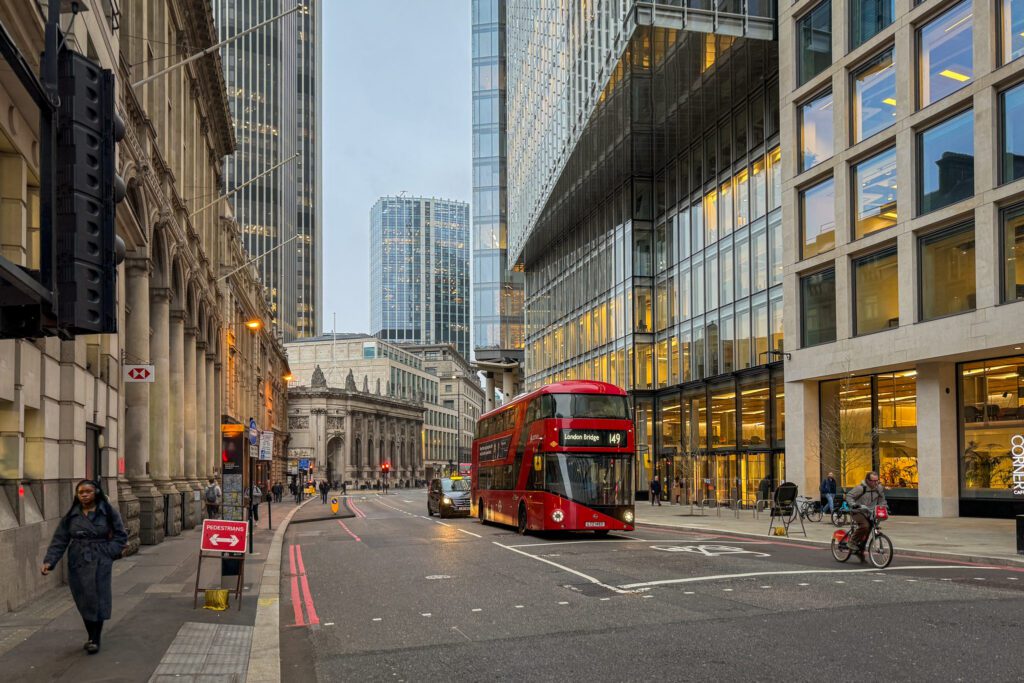
If you’re confused about why there’s a section here called “the City of London,” it’s because that’s the name of the borough here, which roughly corresponds to the original walled city that has been perched here for centuries.
This part of London, which seems like the most modern part of town today, is one huge contradiction in our minds.
On one hand, this is the historic center of London, where the city of London was located back in Roman times (then it was known as Londinium), perched on the north bank of the Thames.
There’s a piece of the original wall still standing, and you can learn about London’s history at the excellent (and free!) London Museum.
What is confusing to us is the fact that this is also the most modern part of London.
The financial district, if you will, is located here, and is full of huge modern skyscrapers. Normally, when you hear “old town,” what comes to mind is charming narrow streets and older buildings. Not here!
Why, you ask?
The answer is complex, but we learned at the aforementioned London Museum that it was partially due to the fact that large swaths of the City of London have burned down over the past few centuries, starting with the London fire in the 17th Century that leveled three quarters of the city, and more recently the Blitz in World War 2, which also did significant damage to buildings in Central London.

Those disasters, similar to a forest fire, did two things.
First, they led to enormous human suffering (in the forest fire analogy, I guess it would be tree suffering) and led to the loss of many historic buildings that used to be there.
But you could certainly argue that London would not look the way it does today without them, because those events also set the stage for the modernization of London that we see today, similar to the way a forest fire often leads to a new wave of growth from the ashes.
Anyway, that’s enough about the City of London’s fascinating history, you’re probably wondering why we chose to include it here.
It makes this list because of the central location and excellent connections to the main sights in Central London.
You’ll be walkable to Borough Market, Tower Bridge and the Tower of London, and Spitalfields and Brick Lane.
And there are multiple Tube lines running right through the neighborhood, along with a plethora of buses to take you anywhere else you might need to go.

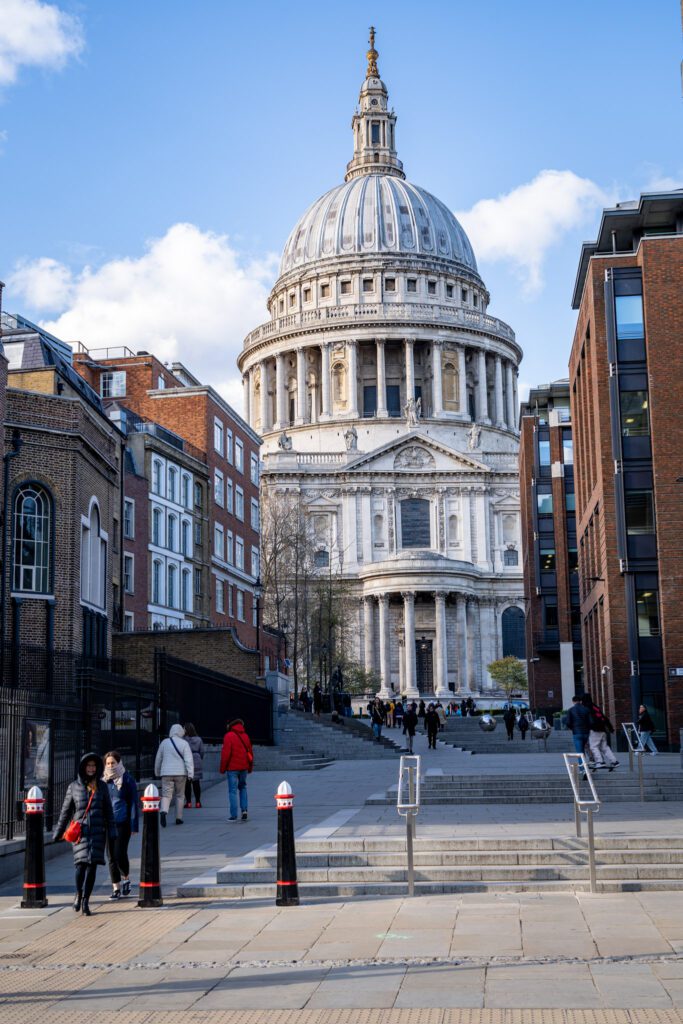
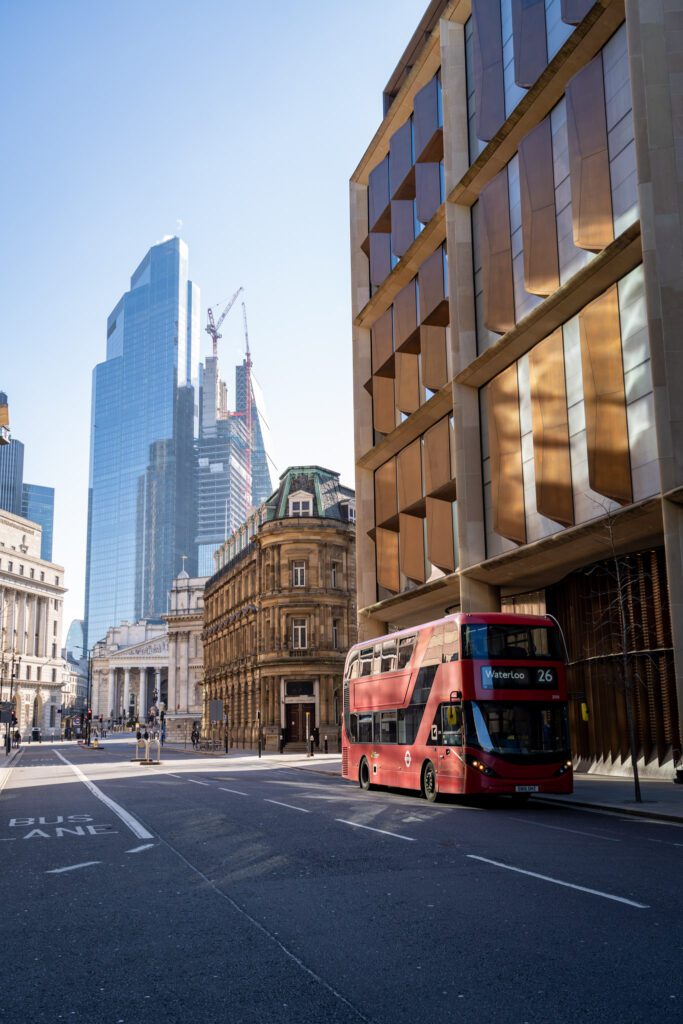
Pros and Cons of Staying in The City of London
Here are the pros and cons of staying in the City of London as we see them.
Pros of Staying in the City of London
The location is great. There’s a reason the Romans chose this as their city center. It’s close to the river, and in today’s London, it’s close to the Tower of London, St. Paul’s Cathedral, and Tower Bridge (among other places).
The connections to the rest of the city. With multiple Tube lines running through the area (namely the Central and Circle/District lines), numerous bus lines that will take you in any direction, and access to the boats on the river, you’ve got plenty of options to get wherever you need to go that’s beyond your walking range.
During rush hour – about 8:00-10:00 am and 4:00-6:00 pm, those options are INSANELY crowded though, be warned.
The atmosphere on weekdays. On warm weekday afternoons, you’ll find scores of workers pouring out of their offices and heading to the local pub, where they stand outside on the curb with a cold beer and their friends (er, mates) and enjoy a pint or seven. Which is a fantastic atmosphere. Weekends, on the other hand…
Cons of Staying in the City of London
It’s DEAD on the weekends. Because this area is mainly office buildings, it’s completely empty on the weekends.
We don’t mind that at all, but it does mean that many of the coffee shops, restaurants, and pubs are closed on weekends (particularly Sundays), so you’ll need to head elsewhere.
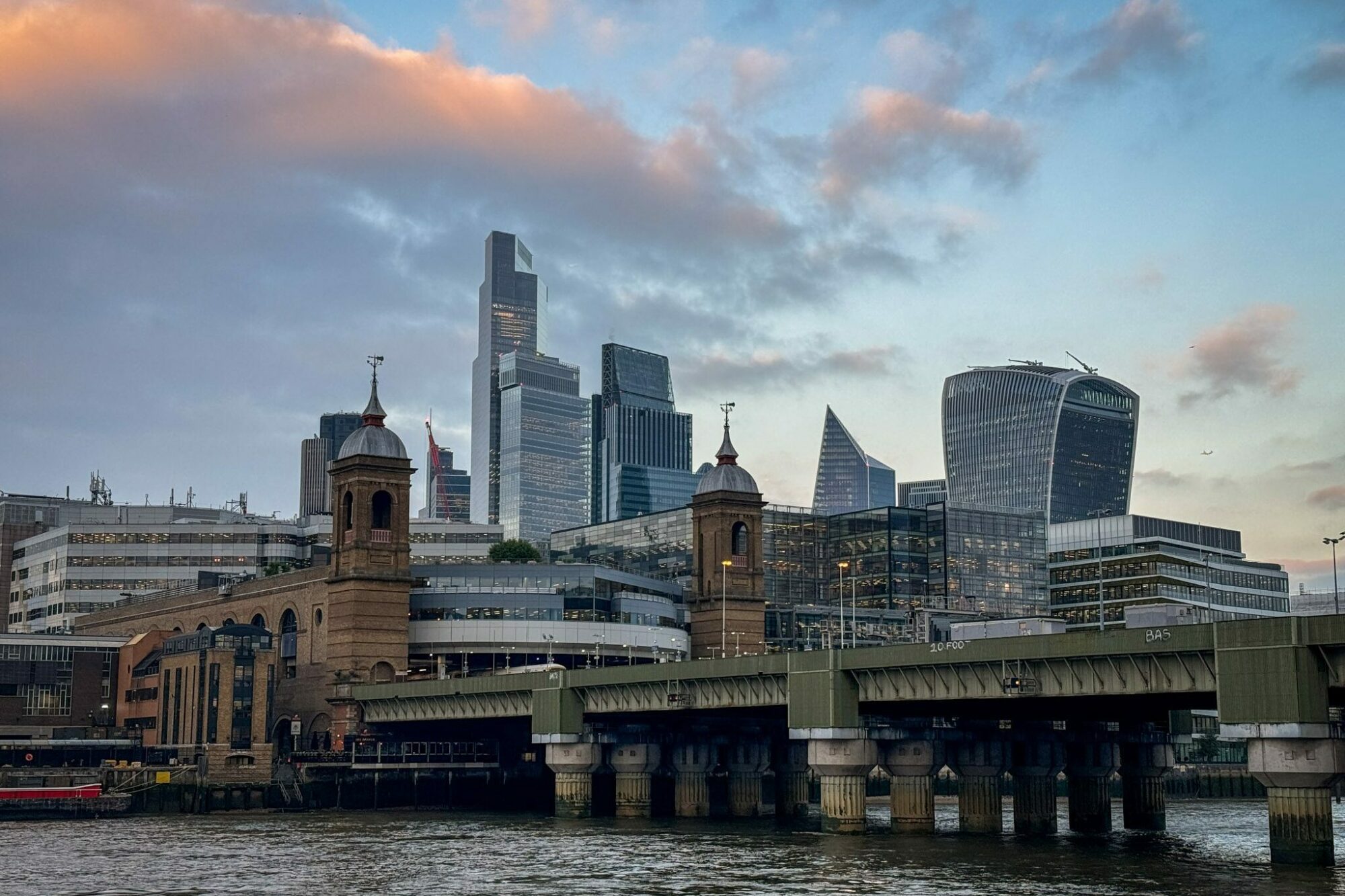
The Best Places to Stay in the City of London
Here are some places to stay in the City of London that stood out to us.
CitizenM Tower of London: A Great Value in an Incredible Location
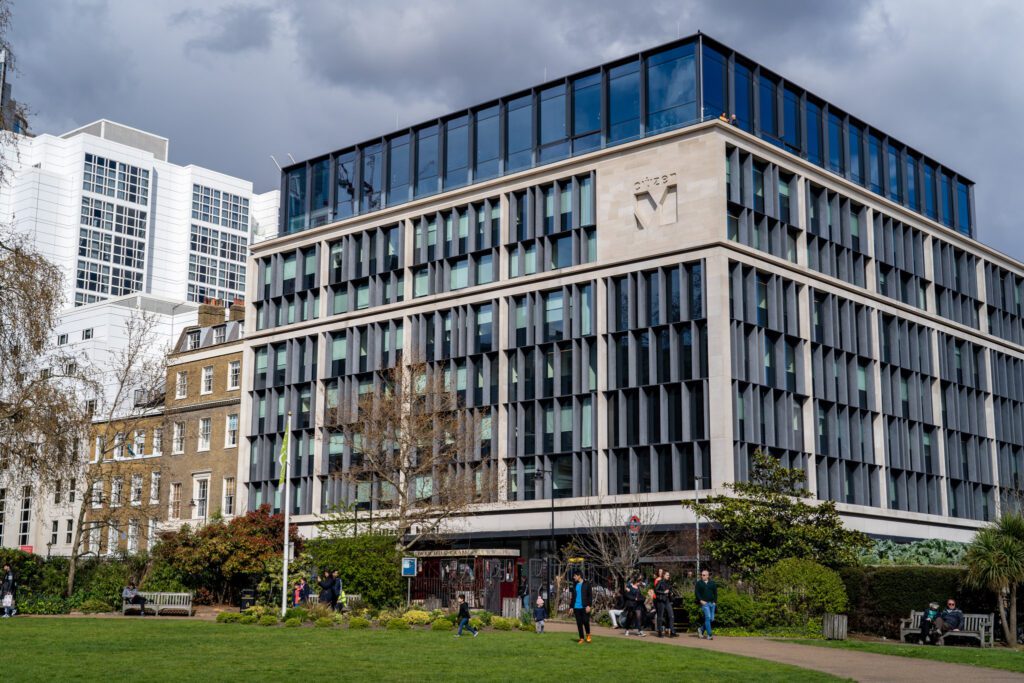
If you missed us waxing poetic about CitizenM in the Bankside section above, go read that for why CitizenM is our all time favorite hotel chain in the world.
We’ve stayed at multiple CitizenM properties around the world (including the one in Southbank), and they deliver an excellent night of sleep at an affordable price every single time.
Rather than talking about CitizenM’s offering, let’s focus on this particular hotel, which has some great features that actually take it a step above the usual CitizenM Hotel.
First is the location. It’s quite literally next door to the Tower of London, walkable to Tower Bridge and St. Paul’s Cathedral (among other things), and well connected via public transportation like buses and the Tube.
Second is the rooftop bar with views of the City of London and Tower of London. We meant to make it here based on the advice of the staff at the Southbank location, but didn’t quite make it happen.
Third is the views from some of the rooms. Whichever direction you’re looking in, you’re pretty much guaranteed to have a nice view from the external rooms, though the rooms overlooking the Tower and Tower Bridge are probably the best of the bunch.
CitizenM is always a great value – that’s their whole thing – and the extra touches at this particular location make it an excellent place to stay.
Native King’s Wardrobe: Great Aparthotel at Foot of St. Paul’s (Where We’ve Stayed)
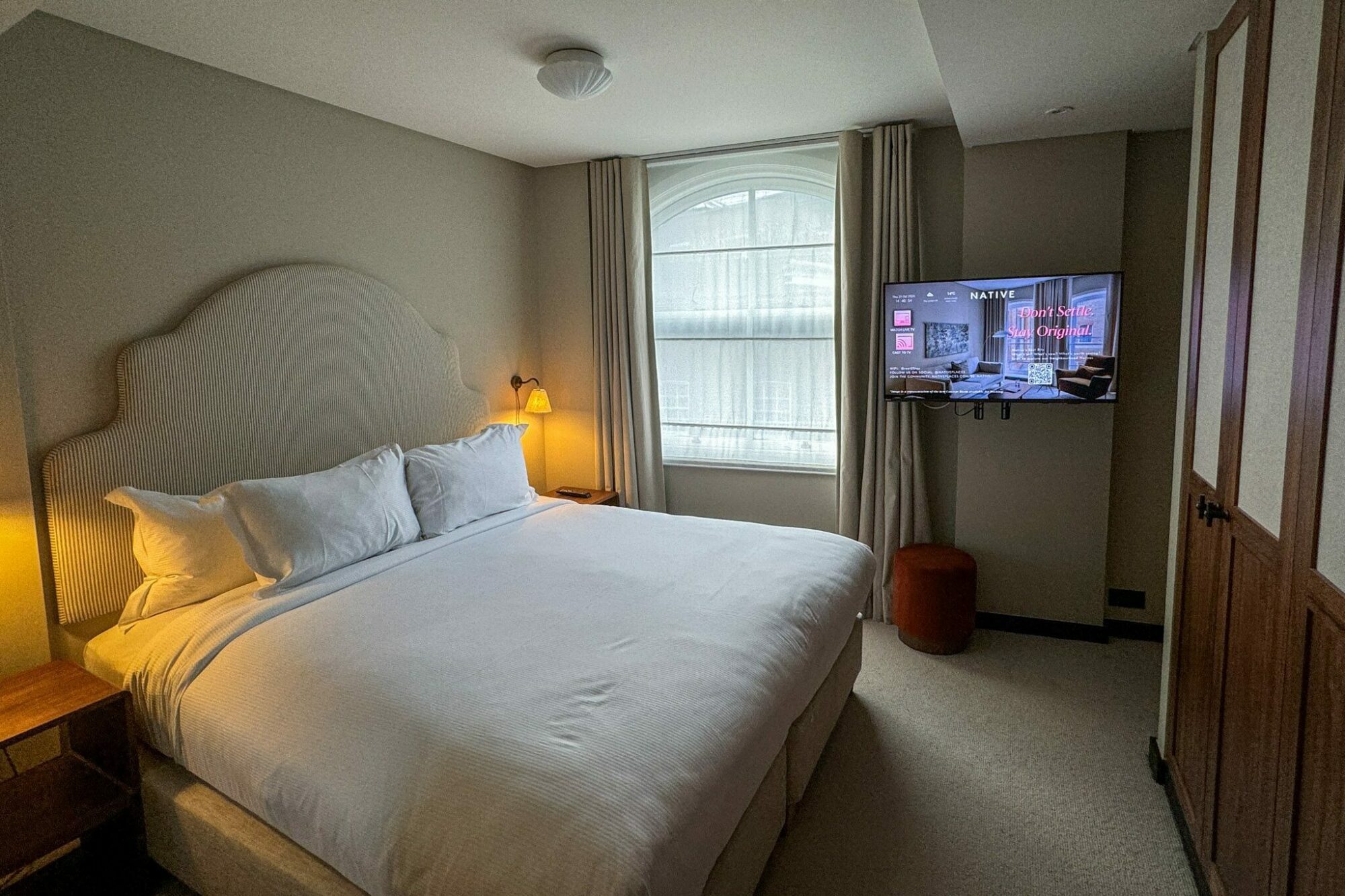
A great option if you’re looking for a bit more space (or you’re traveling with a family and need multiple bedrooms), this charming aparthotel is inside a very old building right at the foot of St. Paul’s Cathedral.
While the bones of the building are old, the apartments are very nice, and this was my favorite place we stayed on my latest trip.
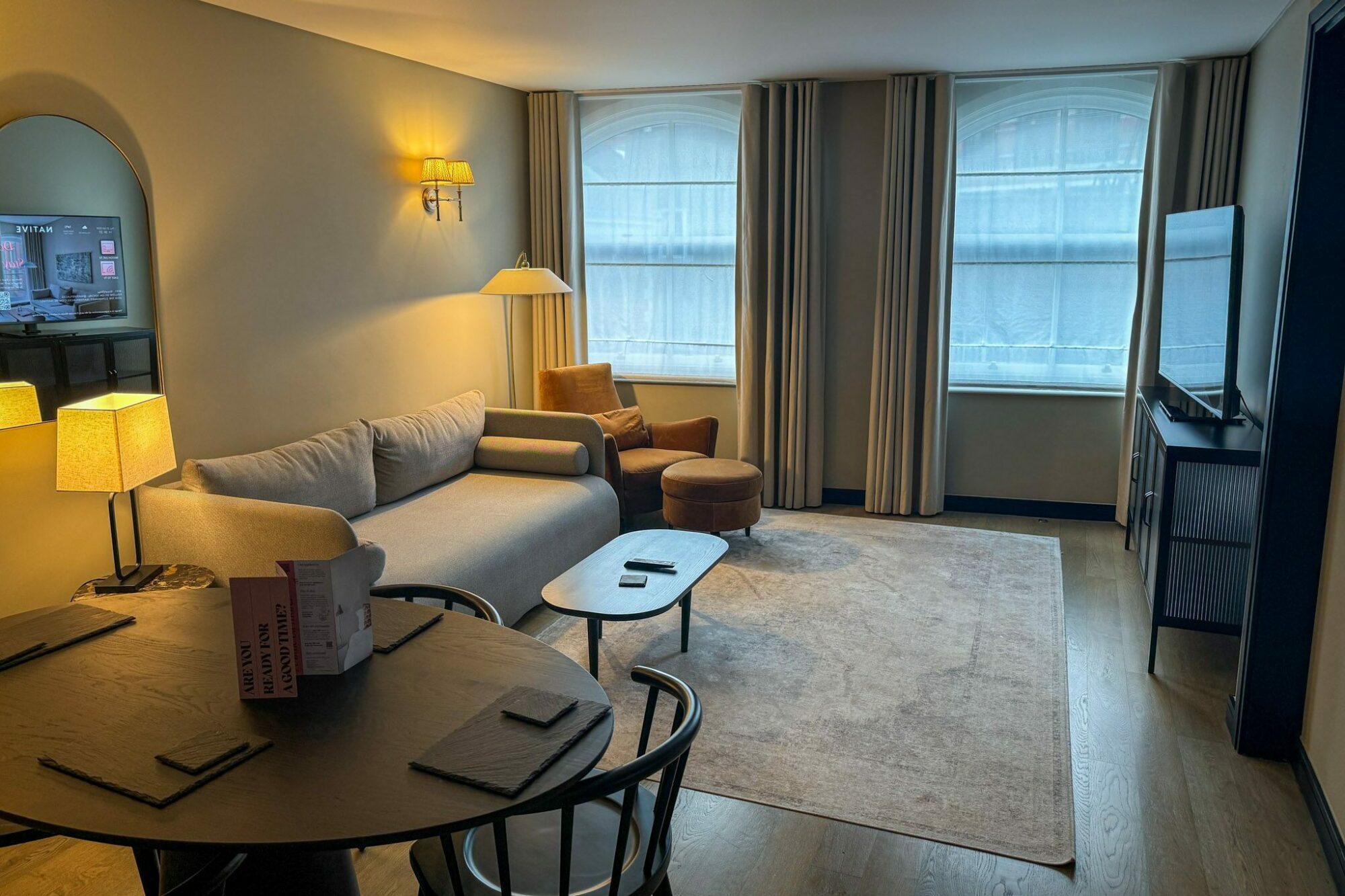
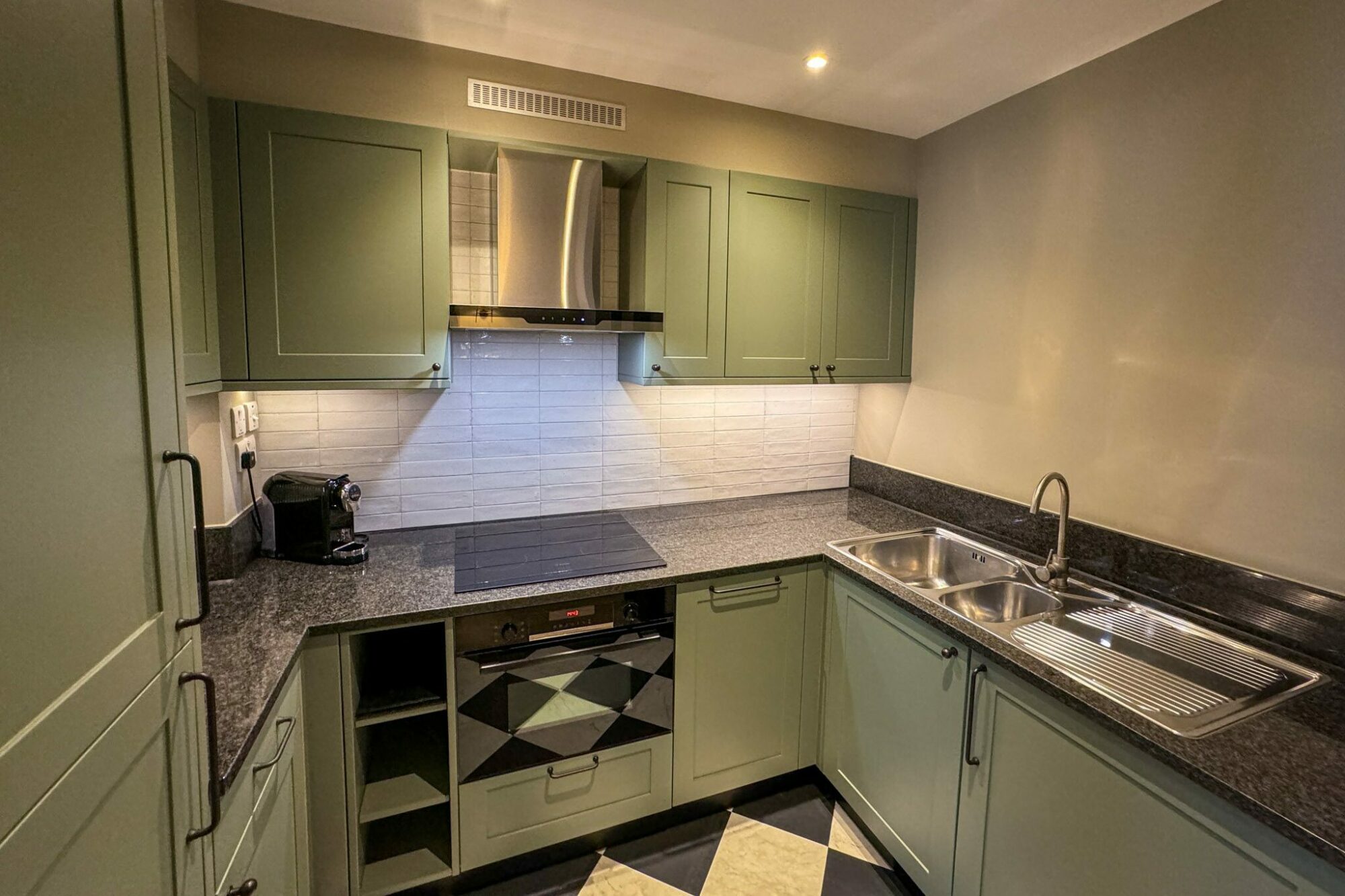
It’s a great location – you’re five minutes on foot from the Millennium Bridge (which takes you to Bankside) and two metro stations, plus bus 26 which takes you to both Shoreditch / Hackney AND Covent Garden / the West End.
Seriously, the location here could not be better.
Apartments come in a couple of configurations, from studios to three bedroom apartments.
The front desk is staffed 24/7, which means you can store luggage and, generally, get all of the amenities of staying in a hotel with the comfort and space of an apartment.
COVE Cannon Street: Stylish Apartments, Perfect Location (Where We’ve Stayed)
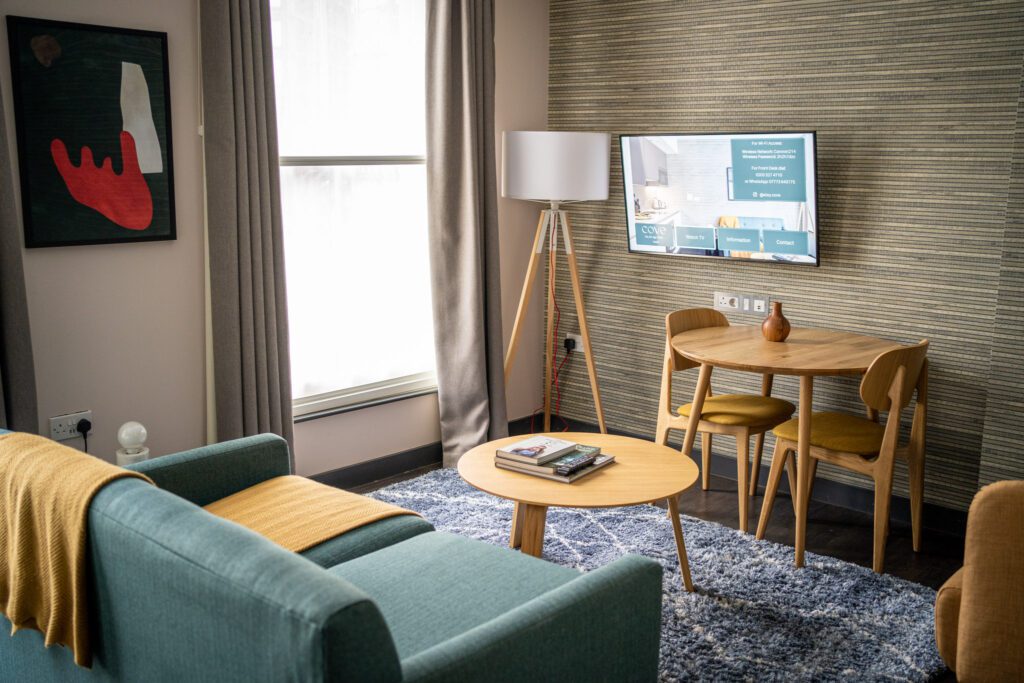
We stayed at Cove Cannon Street for our last few days in London on our two week extravaganza a few years back, and were pleasantly surprised at how nice it was.
We always gravitate towards apartments when we’re traveling for two reasons.
First, Matt has Celiac Disease and needs to eat strictly gluten free, which means having access to a kitchen is almost essential (although London is packed full of amazing gluten free food, which you can read about in our gluten free guide to London).
Second, the extra space is nice when you’re doing work on the road (which we usually are). We can only take so much of working on the bed in a hotel room before it gets tiresome.
However, apartments (especially vacation rentals) have some serious downsides, like the lack of ability to leave bags if you arrive before check in, and the lack of onsite staff to help with issues that pop up.
With COVE, you get the best of both worlds! They blend the convenience of staying in a hotel with the extra space and access to a kitchen that you get by staying in an apartment.
This particular property has a 24 hour reception, so you can leave your bags when you arrive (a major pain point with vacation rentals!).
Plus, we always enjoy talking to the friendly staff to get any recommendations or inside knowledge we should know about the area, and we spent ten minutes at check-in chatting with the extra friendly staff at the front desk here.
They have apartment configurations ranging from studios (we stayed in a “Superior Studio,” which was perfect), to one bedroom apartments that are all efficiently designed, with full kitchens (inclduding ovens and dishwashers) and washing machines in all units.
Bigger groups of 3-6 should look at their other location in Covent Garden for two and three bedroom options in a similarly great location.
Staying here also means you’re literally across the street from the Rosslyn Coffee, where you can get your morning dose of caffeine before heading out. Plus, it’s just two blocks from St. Paul’s Cathedral!
Shoreditch / Spitalfields: Best for Hipsters, Artists, and Nightlife
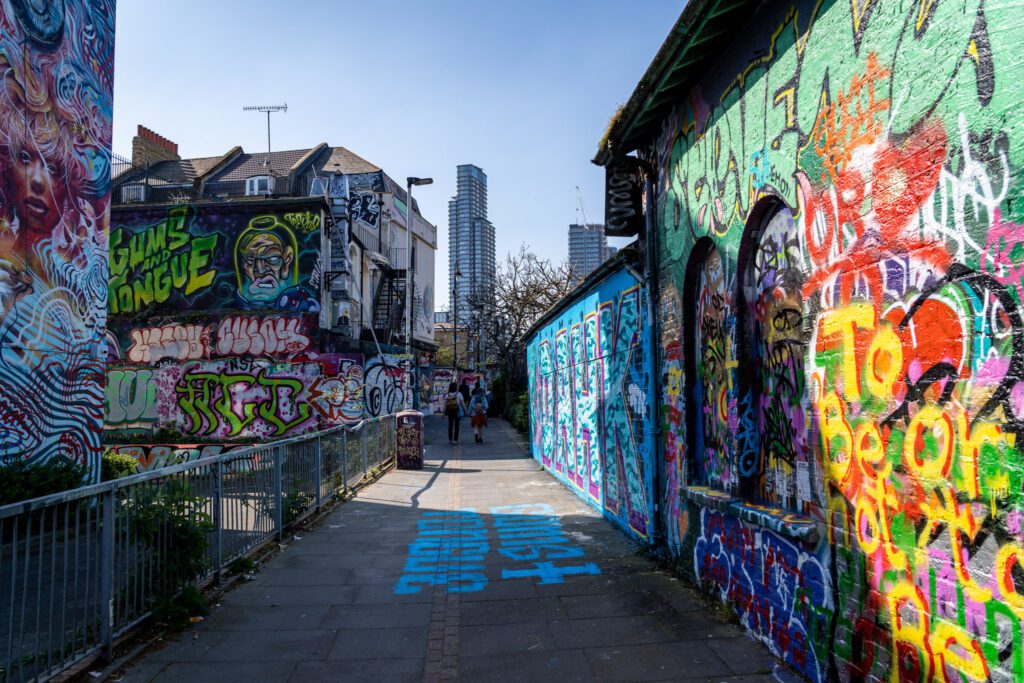
We’re not sure we’ve ever seen a higher concentration of vintage stores than we saw in Shoreditch. And that tells you a lot about this hip neighborhood in northeast London and the transformation it has undergone in the past decade or two.
At one point, Shoreditch was completely separate from the city of London, but over the years the borders of London have continually expanded, swallowing up former suburbs on its way to becoming the city it has become today.
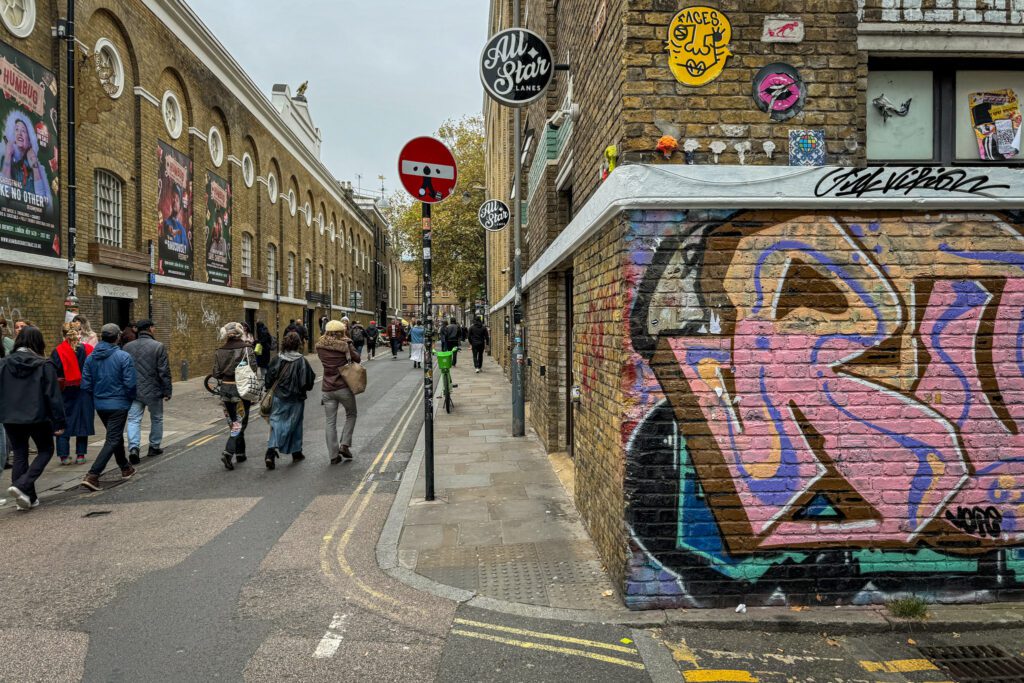
Even the origin story of Shoreditch is a little counterculture.
It became famous because in the 16th Century, some politicians got the idea that banning playhouses (and theaters) in London sounded like a good idea. Imagine what they’d think if they saw London today!
So, in order to meet the demand that certainly hadn’t evaporated despite the ban, new theaters were built in places like Shoreditch and Southwark, which at the time were outside of the city limits, and thus its jurisdiction.
In the 19th and early 20th centuries, it was a legitimate rival to the West End as the center of London’s arts scene.
After the second world war, during which large swaths of the neighborhood were demolished – including a lot of housing – the reconstruction process took a little longer than other parts of London.
To make matters worse, globalization led to the relocation of many of the factories in the area. That left a lot of industrial buildings that were empty, which is evident today as the whole area has taken on a very “industrial-chic” vibe.
Since then, the story of Shoreditch is similar to many other highly gentrified areas in major cities around the world.
First the artists moved in, creating a demand for businesses that those artists liked, and finally ending with astronomical housing prices that drove out many of the original residents (and those artists, too) and brought in a more wealthy contingent, who in turn brought a different set of businesses to cater to their different needs.
We’ve seen that story in cities that we’ve lived in, like the Mission District in San Francisco, or Capitol Hill in Seattle.
In our minds, the story of Shoreditch feels very similar to those stories, and while we think there’s a lot of cool places to see, eat, and drink in the area, it’s worth keeping in mind the context behind how those places came to be. If you want to know more about its history and gentrification, read this.
Note: We’re going to combine a few different areas, including Spitalfields and Shoreditch, into this section. Technically, they’re distinct neighborhoods, but we don’t think they are distinct enough to demand their own sections and we’d recommend both of them.

Pros and Cons of Staying in Shoreditch / Spitalfields
Here are the pros and cons of staying in Shoreditch as we see them.
Pros of Staying in Shoreditch
It’s hip. We’ve never seen so many vintage stores as we did on Brick Lane. And they have an entire store dedicated to plant-based cheese (with an excellent name, we might add – La Fauxmagerie).
The weekend markets are awesome. There are two excellent markets in this area, and we went to both twice because we enjoyed them so much.
First is Spitalfields Market, which is open everyday but is at its best on Saturdays at the arts market, when it’s filled with stalls selling all sorts of fun stuff (there’s food, arts and crafts, and more).
Second is the Sunday Upmarket on Brick Lane, which has an incredible food section with stalls selling food from all corners of the globe. Despite the name, it’s open both Saturday and Sunday.
The food and drink scene is great. Even excluding those two markets, the food and drink scene in this area is fantastic. Dishoom (a popular Indian restaurant chain) has a location up here, and there are so many bars which makes this one of the better places in London to head to after dark.
Cons of Staying in Shoreditch
It’s busy, loud, and boisterous. This is not an “off-the-beaten-path” neighborhood. It’s packed full of people at most hours of the day. Due to the nightlife, it can also be loud after dark.
Gentrification. While the ship has largely already sailed on the gentrification of Shoreditch, it’s worth keeping in mind as you decide where to stay.
A few decades ago, this was a relatively poor part of London that has since seen skyrocketing costs of housing due to its popularity with tourists and Londoners, forcing many of the original residents to relocate.
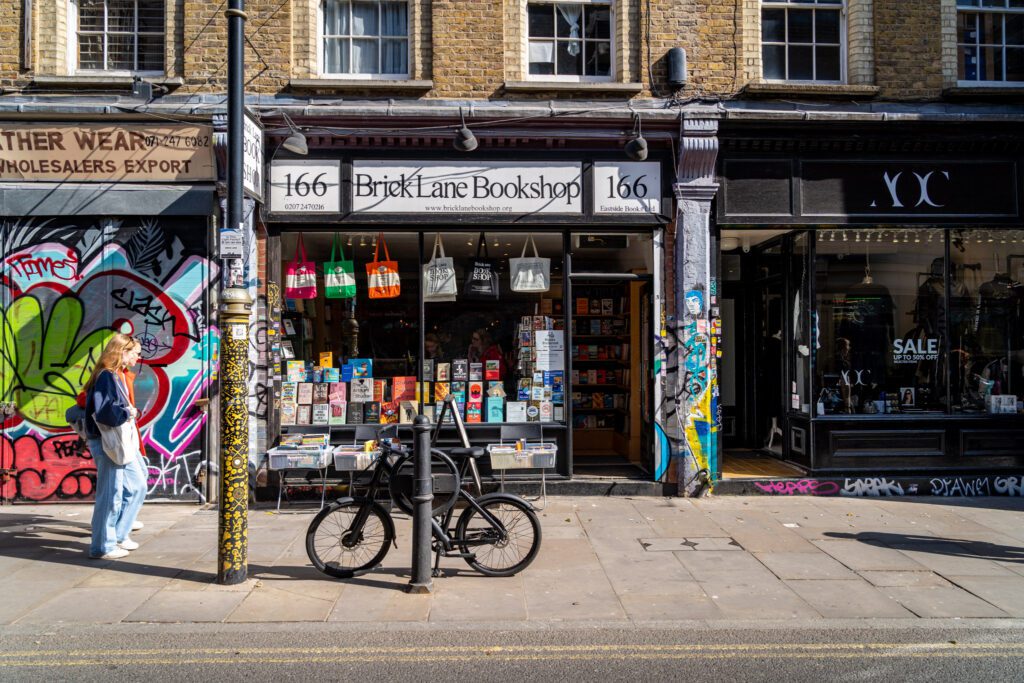
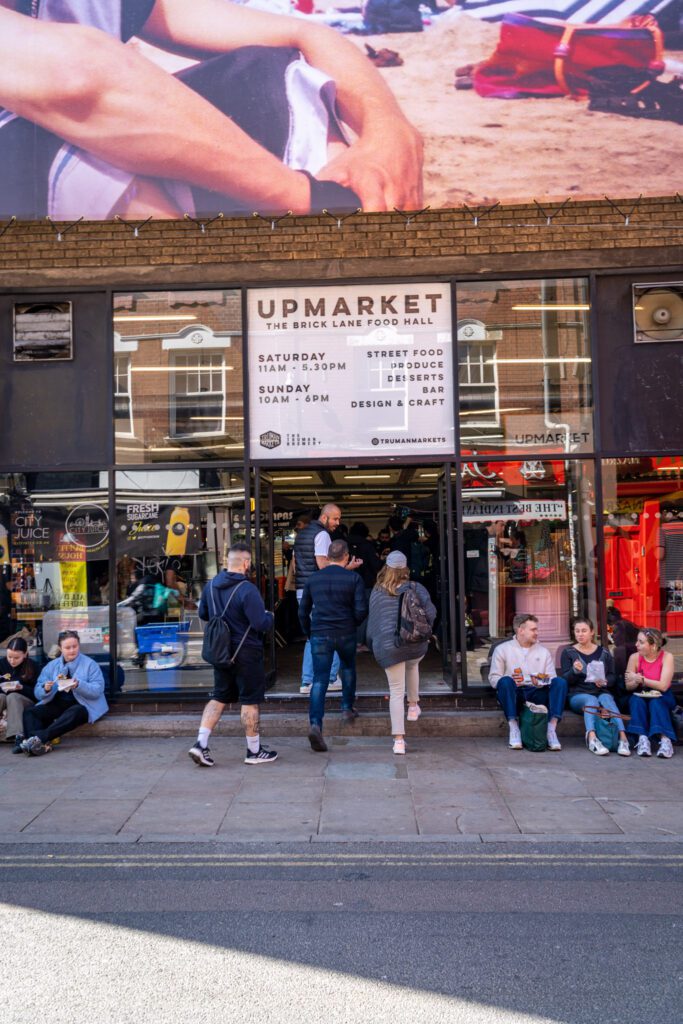
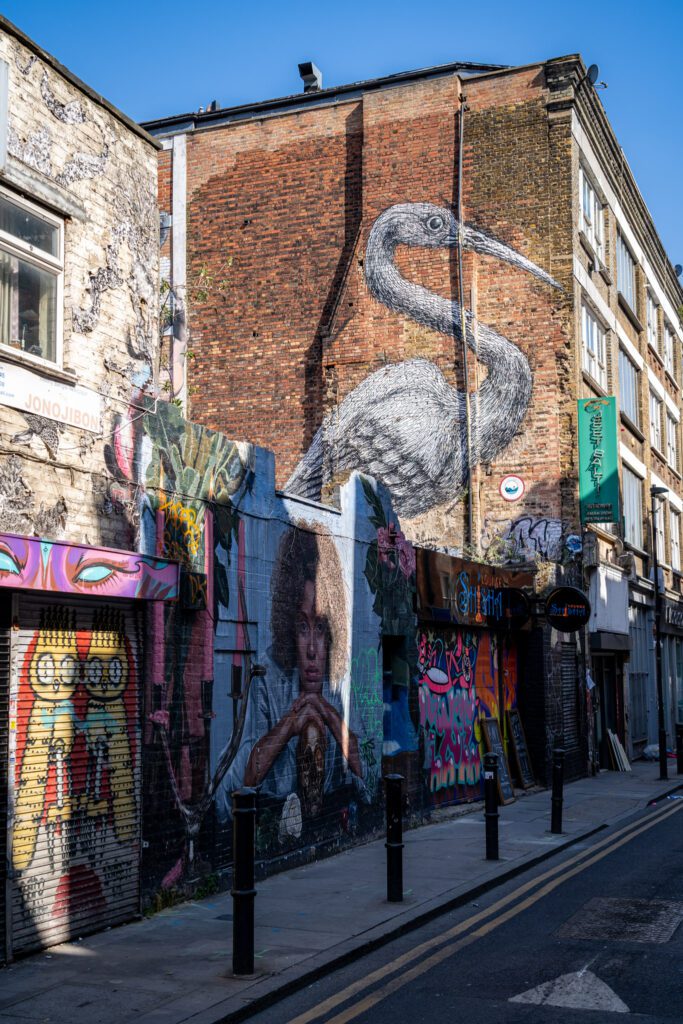
The Best Places to Stay in Shoreditch / Spitalfields
Here are some places to stay in Shoreditch and Spitalfields that stood out to us.
We’re not writing up the other CitizenM location in London – CitizenM Shoreditch – because two locations seems like enough for you to get the vibe, but that’s another option in the neighborhood.
One Hundred Shoreditch: A Beautiful Hotel in the Heart of the Action
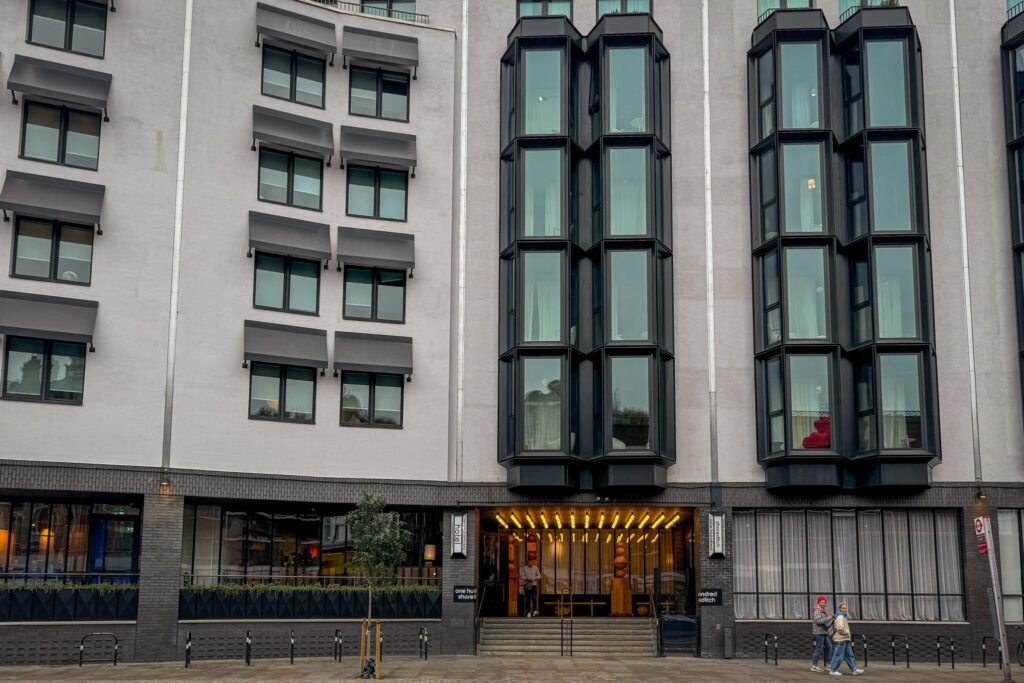
This beautiful hotel is right along one of Shoreditch’s main drags, and staying here puts you within a short walk of places like Brick Lane and the Sunday Upmarket, along with all of the cocktail bars and places to eat, drink, and socialize in Shoreditch itself.
Plus, a short bus ride to Broadway Market and the Columbia Road Flower Market – two of our favorites!
It’s a big hotel – they have 250+ rooms – and the rooms here are called “studios”, but they have a similar amount of space and amenities to normal hotel rooms (no kitchens), so it doesn’t seem like anything more than marketing.
The studios come in a range of sizes and configurations, with some offering a bit more room to relax and seating than the basic studio, which basically is just a bed and a chair.
They do have some rooms that come with their own private terraces, and they have interconnecting rooms that can house groups of four or six people traveling together.
In terms of amenities, they have a “Peloton Studio” (read: a basement room with a few Peloton bikes) for you to use to get a quick sweat in.
The Culpeper: Rooms Above a Pub + Great Value
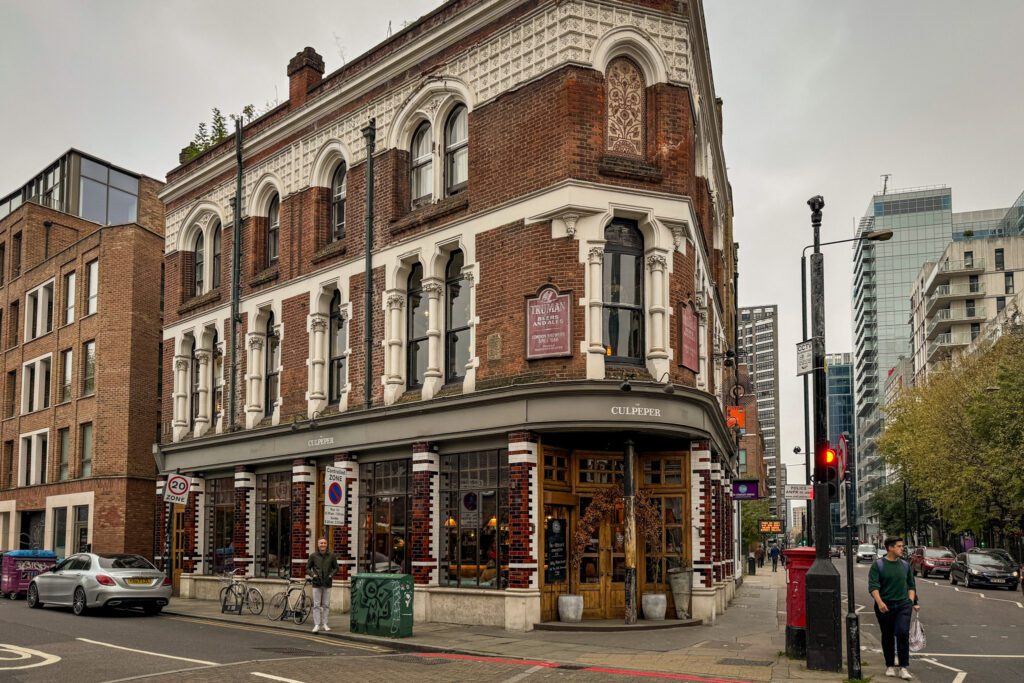
If you’re looking for the unique experience that is staying in the rooms over a pub – which feels very British to us – the Culpeper is a great option.
We actually stopped by here for a drink, and spent our entire time inside admiring the industrial-chic decor of the pub, with fun light fixtures and beer taps.
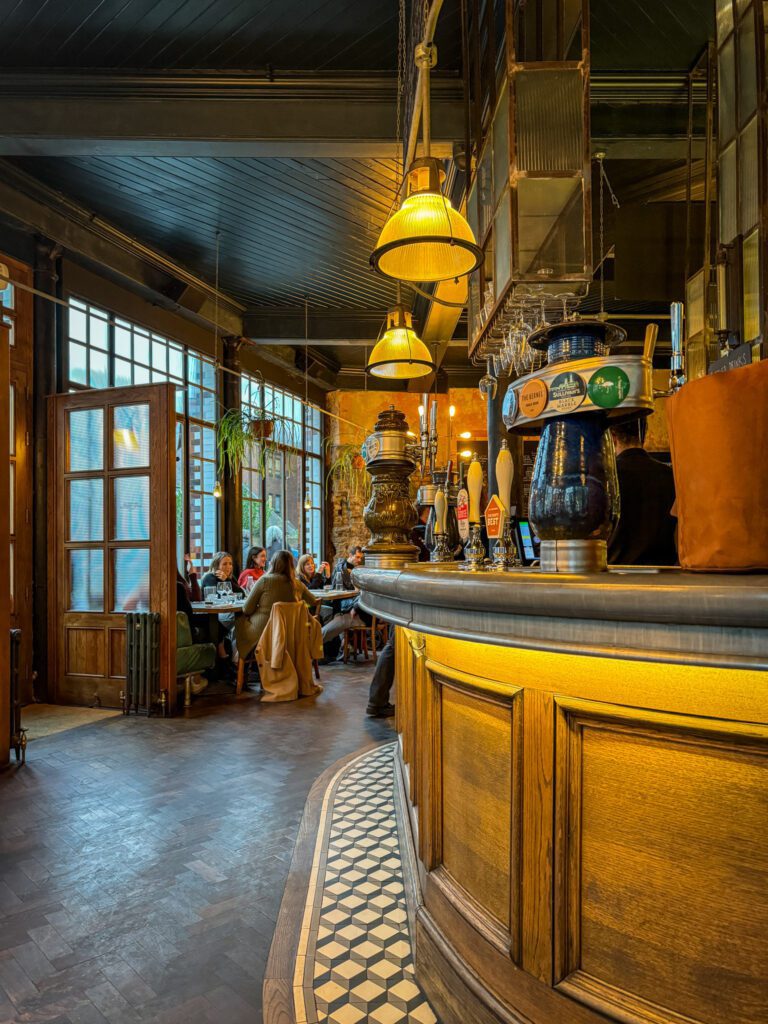
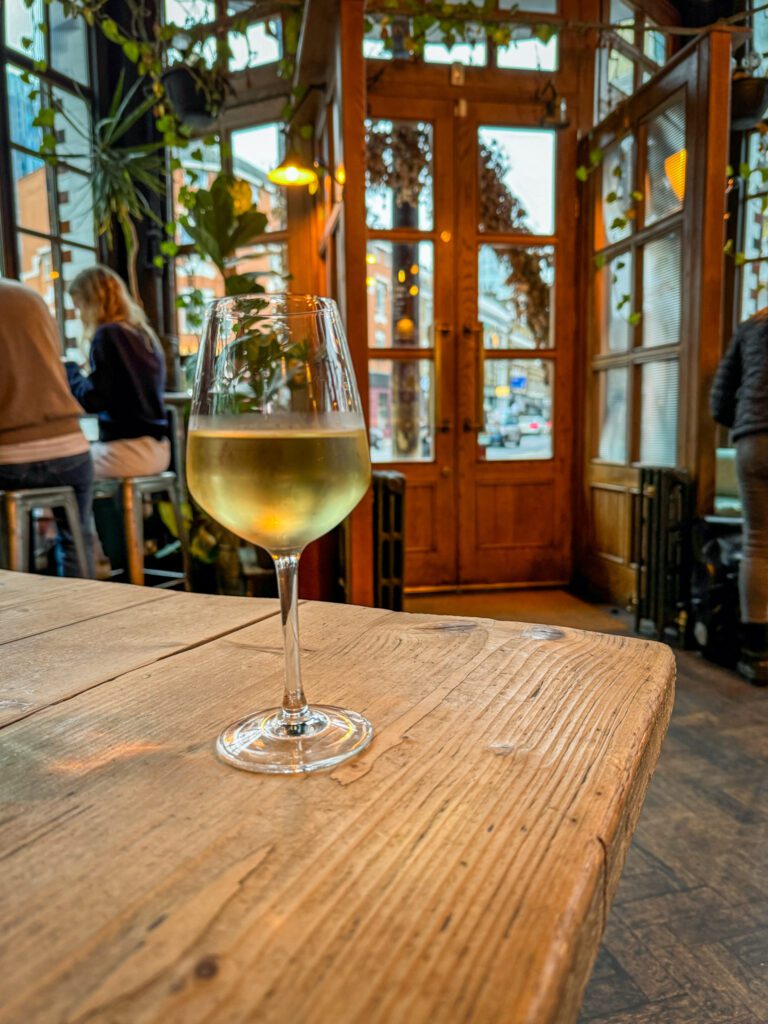
It’s a couple of blocks from Spitalfields Market (a must-visit for both food and local crafts, we think), and 5-10 minutes from Brick Lane and the Sunday Upmarket.
The whole idea here is that you aren’t going to be spending a whole lot of time in your room – you’ll be out exploring the city – so all you really need is a comfortable place to sleep (which is true for short trips, but we like to have a little extra space when we’re in a place for longer than four nights).
Rooms here include breakfast at the pub in the rate, and the vibes are cozy and comfortable (we’re big fans of the green tile work in some of the bathrooms!).
Overall, staying in a room above a lively pub is a unique experience that you probably wouldn’t get at home (at least if you’re from the US), and the affordability of the rooms here is a big plus in their favor.
The Buxton: (Smaller) Rooms Above a Pub + Great Value
Another great option for rooms above a lively pub is the Buxton, which is a block east of the Culpeper. Fun fact: we had a room booked here for our fall 2021 trip to London that eventually got cancelled and moved to the next spring.
It’s actually owned by the same people as the Culpeper, but the offering here is slightly different than the Culpeper. Rooms are smaller and simpler, but the price reflects that and offers a great value given the location.
Don’t plan on spending a whole lot of time in your room – you have access to their rooftop garden (which has nice views of London), and the pub below is a nice place to relax and grab a drink, catch up on journaling, or watch a show.
Three More Great Neighborhoods in London
As we mentioned in the introduction above, there are three more neighborhoods in London that we personally love, but only make sense as a home base for exploring the city if you either have a little extra time (more than four days) AND have been to the city before and are looking for something a little more residential where Londoners actually live.
This section is going to be a little more stripped back and structured differently, giving an overview of those three neighborhoods, why I (Matt here, who was in London most recently) like them, and a couple of places to stay in each.
Islington (Specifically, Angel): My little brother and I spent quite a bit of time exploring Islington over the course of that recent 10 day trip, hopping from one coffee shop or neighborhood pub to the next as we explored on foot, passing countless terrace houses (we call them row houses).
If I was moving to London tomorrow, it would be a tossup between this part of the city and Bethnal Green (more on that in a second), which are two of the most charming neighborhoods in London we came across.
In particular, we like the southern end of Islington around Angel, which offers nice connections to central London and all the tourist attractions you find there with a more residential vibe.
As you might imagine, there aren’t a whole lot of places to stay in this specific part of the neighborhood, but you do have Citadines Islington and a fairly affordable Hilton.
Bethnal Green: As we were sitting at lunch on our last day in London, I asked my brother to rank the five markets we visited.
We both ranked Broadway Market at the top of the list (and, because actions speak louder than words, it’s worth noting that we went to Broadway Market three out of a possible four days we were in town).
Broadway Market is in London’s East End, north east of the central core of the city. As you leave Shoreditch and the City of London’s skyscrapers behind, you start to see a lot more terrace houses, open green spaces, and young families pushing strollers, and the commercial vibe gives way to something far more residential and charming.
There’s a Mama Shelter a few blocks south of Broadway Market and London Fields, the part of the neighborhood we fell in love with, which puts you on the northern border of Shoreditch.
Camden Town: While the two previous neighborhoods in this section are a bit more polished and charming, Camden leans more in the direction of punk in its vibes.
Which isn’t surprising when you consider that this is the part of the city where artists – including famous punk musicians – lived in the 70’s and 80’s. The late Amy Winehouse is a famous former resident, and there’s a statue of her at Camden Market, which is a must-visit on any London itinerary (the market, not the statue).
Again, more residential in this part of the city – which is due north of the city’s core – and your only options are a Holiday Inn and a nice boutique hotel just outside the most popular part of Camden.
Where NOT to Stay in London
After thinking about my experiences exploring London and its various neighborhoods, there are a few places I would immediately cross off of your list as you’re narrowing in on the “best” place to stay for your particular style and budget.
First, I’d immediately cross off any neighborhood south of Southwark/Bankside, which is directly along the south bank of the River Thames.
The reason is simple: the Tube connections just aren’t very good or comprehensive, so it’ll probably be a lot of bus-tube connections that will eat up time.
Second, I wouldn’t stay in SoHo or the other parts of the West End (the area around Oxford Circus and Leicester Square).
Great to visit – and I absolutely would not miss catching a show in the West End, which is second only to Broadway (my opinion) in terms of theater scenes around the world – but they’re WILD in terms of crowds and noise.
Plus, the bars and restaurants you find here are generally going to be strictly okay, at best (that’s a generalization – there are some good places to eat here – but the quality is significantly lower and you’ll find more chains than other parts of the city).
Third, I wouldn’t stay in Westminster or South Kensington.
Westminster – aside from its proximity to things like Big Ben and Westminster Abbey – just isn’t that cool, I’d argue. I’d prefer to stay on the other side of St. James’ Park in Covent Garden.
South Kensington is very bougie (the hotels skew towards the luxury side of the spectrum) and has nice access to green spaces and museums, but the price tag is going to be steep, and you’re going to find yourself wishing you had stayed more centrally, I think.

I really appreciated this. I’m going back (from Australia) to the UK to live for a couple of years and trying to decide which area would suit. I previously lived in Kensington which is lovely although very expensive now.
Shoreditch and Camden look rather interesting. I look forward to checking out the cafes, restaurants and vintage stores you recommended. Cheers 🙂
Shoreditch and Camden are both great, especially the markets that exist in both of them. We’d eat at Camden Market everyday if we lived there (plus Regent’s Park is amazing, too). Cheers!